

How to Make College Assignment Heading
Table of Contents
The General Assignment Header Guidelines
How to head an assignment, page formatting heading rules, why college assignment heading is important.
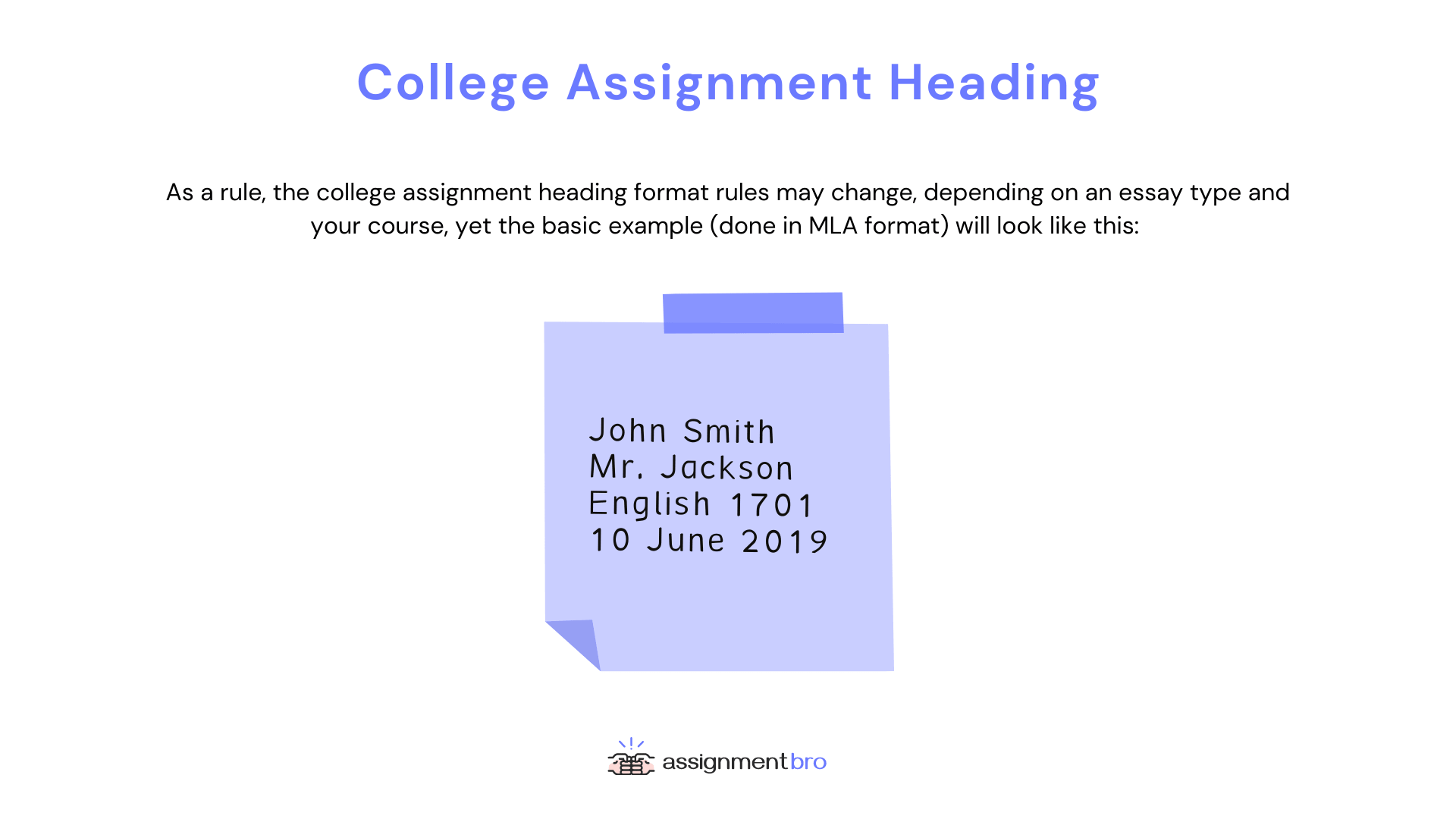
If you have written at least one assignment, you must have faced a college homework heading. You might remember how it is done in MLA style (at the very beginning of your paper) where the student’s name must be included on the first page, followed by the professor’s name, course name, and the delivery date. It is the most widespread assignment heading that students get to learn. It has a clear purpose: to help college professors identify the paper and enter relevant information in the grading book.
As a rule, the college assignment heading format rules may change, depending on an essay type and your course, yet the basic example (done in MLA format) will look like this:
John Smith Mr. Jackson English 1701 10 June 2019
According to the MLA Style manual , it is obligatory to place this information in the top left corner of the front page with the header’s inclusion of the student’s last name and the page number in the top right corner. Depending on your academic writing format, it may be necessary to compose your assignment’s header in Chicago or APA format, which will require specific templates.
What makes all formats unified, however, as you learn how to title things, is the student’s name, the title of the paper, course name, institution, professor, or academic advisor being mentioned, and the date of the research project or an essay.
Regardless of what formatting style you have to follow or when you ask for online essay assignment help , make sure that you locate and write down the following information:
- Identify the paper style that you have to implement for your assignment. It is necessary to include all the necessary details that will be unique if it is a lab report or a research paper.
- Headings and margins. It is vital to make sure that your paper meets the same page margins from all sides. In most cases, it will be a 1-inch margin.
- First and Last Name must be included exactly in the same way as it is mentioned in your student’s card. The same relates to online courses to help keep your grading book active.
- Professor’s name part has to come next in most academic formats. Remember that in certain cases, it is necessary to consult with your college professor since it may be either “Professor Jones”, “Dr. Jones”, or simply “Jones” unless specified otherwise.
- The Course Name. This college assignment heading part may include a special code for your course like “ENG 201” or “Social Sciences Unit”. Always consult your academic advisor to get things right. Specifying the wrong course may not be considered a serious offense, yet your final grade may be deducted.
- Date. It always depends on the country and the calendar style that is being used. It is one of the most common mistakes that modern students make as they do not check this part in advance or pick examples from the Internet. The military date style is preferred in most cases.
Remember that the title of your paper should always be centered and double-spaced, according to most formats. The only exception is the inclusion of running headers in APA format, which will always be aligned to the left and will include CAPS and a shortened title of your paper. The latest edition of APA 7 does not require the “Running Head” prefix and only asks for the paper’s title, all in capital letters.
Your assignment can be completed in 3 hours!
Has your deadline come quicker than you expected? No worries! We have what you need – a 3-hours deadline option! All features available for any other order applied, including:
- 100% original assignment
- Free formatting and reference list
- 24/7 online support
While these often differ between styles, the majority of academic formats will also require learning about the page layout rules . Even when you download freely available assignment header templates from the web, make sure that they have:
- One-inch margins on left and right, top, and the bottom of the page.
- Times New Roman, 12 point font is used or Arial 12pt.
- Text and heading part must be double-spaced.
- Text of the paper is aligned to the left with the 1/2 inches indent for every paragraph.
- The block quotes must follow the same rule.
- Your bibliography part should use hanging indents for every second line of the reference, which also relates to the general heading guidelines for college assignments.
In case of doubt, always consult a relevant style manual!
Working with a cover page for a university assignment is a part of every curriculum, which is a reason why so many professors recommend passing the general English course. It will help to learn how to format your tasks accordingly. It may seem challenging at first, yet knowing how to write a professor’s name on paper will also help you to avoid plagiarism and embarrassment when you send the wrong assignment by accident. Once there is relevant information found in your assignment heading, educators from the other courses or fellow students can easily find and identify every lost college paper in case of necessity.

What is an Assignment and Why Do We Need it? An assignment is a set task students or employees must complete as part of their study or job role and is usually presented in written form...
What is an Assignment and Why Do We Need it? An assignment is a set...
Knowing how to avoid plagiarism in the assignment is one of those skills that many college students learn the hard way when they face high similarity plagiarism reports. It doesn't even...
Knowing how to avoid plagiarism in the assignment is one of those...
What Is A Report For An Assignment? Contrary to a popular belief, a report for an assignment is not a simple outline. It is a deep analytical work that must be done. It is often approached...
What Is A Report For An Assignment? Contrary to a popular belief, a...
We use cookies to give you the best experience possible. By continuing we’ll assume you board with our cookie policy .
Have a language expert improve your writing
Run a free plagiarism check in 10 minutes, generate accurate citations for free.
- Knowledge Base
- Academic writing
- How to write effective headings
How to Write and Format Headings in Academic Writing
Published on March 15, 2019 by Shane Bryson . Revised on July 23, 2023.
The goal of using headings in a document is not only to divide information, but also to allow easy navigation of the document. In academic writing , headings help readers find the specific information they want while retaining a sense of how that information fits with everything else in the document.
To test for overall heading clarity, ask yourself the following: from reading your headings in sequence, would an informed reader understand…
- The content of the document as a whole?
- The specific content of each section?
- How each section fits with the others?
If not, your headings aren’t effective , and may need some improvement.
Instantly correct all language mistakes in your text
Upload your document to correct all your mistakes in minutes

Table of contents
Headings vs. titles, how long should headings be, using descriptive headings, technical terms in headings, capitalization, formatting and sequencing, other interesting articles.
Although heading and titles are similar, they are distinct: A title leads the entire document and captures its content in one or two phrases; a heading leads only a chapter or section and captures only the content of that chapter or section. Read more in our article on writing good titles in academic writing .
Don't submit your assignments before you do this
The academic proofreading tool has been trained on 1000s of academic texts. Making it the most accurate and reliable proofreading tool for students. Free citation check included.

Try for free
Headings should be as long as it takes to clearly communicate the content of the sections they head. However, each heading should be as concise as possible – a good rule of thumb is to limit the heading length to one line.
Higher-level vs. lower-level headings
Higher-level headings often make do with a single word (e.g. “ Introduction ” or “ Methods ”), while lower-level headings are often longer. This is because higher-level headings cover more general content and provide an overview. One word is clear enough because everyone already knows what happens in an introduction chapter – nothing more needs to be said.
Lower-level headings should use more specific terminology to help clarify the content of the section. These headings help readers find the exact information they’re looking for.
The main goal of a heading is to inform the reader of what content they can find in that section, so make your headings as descriptive as possible. The examples below show one non-descriptive heading and three descriptive headings that provide the reader with much more information.
- Profile of GPS technology
- Function of GPS in aviation
- GPS before 1999
Avoiding repetitive headings
No two sections should focus on the exact same content, so no two headings should be identical. Instead of closing a chapter with “Summary,” for example, try making the heading little more descriptive: “Summary of X .”
Documents in fields that rely heavily on jargon and technical language will contain headings that might not be clear to every reader. That’s fine as long as you keep your reader’s knowledge level in mind. However, if you don’t need the jargon to give a specific idea of your content, then avoid it.
Here's why students love Scribbr's proofreading services
Discover proofreading & editing
At the outset, make a plan for how you will deal with matters of capitalization , formatting and sequencing of headings. Headings at the same level should be formatted the same. For instance, “Section 2.2” should get the same treatment as “Section 4.1”. They should also have parallel structure .
Often, your style guide or university will offer specific directions on how to approach the capitalization, formatting, and sequencing of headings, so it’s wise to check before you start writing them. For example, APA headings and MLA headings require specific formatting.
Using automatic heading styles in Word
To avoid having to format each heading separately, it’s smart to use the heading styles feature offered by Microsoft Word, Google Docs and many other word-processing softwares.
An extra benefit of using these heading styles is that you can automatically generate and update a table of contents. This will save you a lot of time later on. Read more about this in our article on creating a table of contents .
If you want to know more about AI for academic writing, AI tools, or fallacies make sure to check out some of our other articles with explanations and examples or go directly to our tools!
- Ad hominem fallacy
- Post hoc fallacy
- Appeal to authority fallacy
- False cause fallacy
- Sunk cost fallacy
- Deep learning
- Generative AI
- Machine learning
- Reinforcement learning
- Supervised vs. unsupervised learning
(AI) Tools
- Grammar Checker
- Paraphrasing Tool
- Text Summarizer
- AI Detector
- Plagiarism Checker
- Citation Generator
Cite this Scribbr article
If you want to cite this source, you can copy and paste the citation or click the “Cite this Scribbr article” button to automatically add the citation to our free Citation Generator.
Bryson, S. (2023, July 23). How to Write and Format Headings in Academic Writing. Scribbr. Retrieved June 18, 2024, from https://www.scribbr.com/academic-writing/effective-headings/
Is this article helpful?
Shane Bryson
Shane finished his master's degree in English literature in 2013 and has been working as a writing tutor and editor since 2009. He began proofreading and editing essays with Scribbr in early summer, 2014.
Other students also liked
Capitalization in titles and headings, apa headings and subheadings, forging good titles in academic writing, "i thought ai proofreading was useless but..".
I've been using Scribbr for years now and I know it's a service that won't disappoint. It does a good job spotting mistakes”

Find Graduate Programs and Masters degree courses
- Online Master’s
- Cheapest masters Program
- Cheapest Online Masters
- Phd Programs
- Online Phd Doctoral Programs
- Graduate Certificate
- Online Certificate Programs
- One Year Masters
- One Year Online Masters
- Fastest Online Masters
- IVY League Programs
- GRE Score for Masters
- No GRE Masters Programs
- No GRE Online Masters Programs
- Grad School Matcher
- FAFSA Graduate Programs
- Graduate Scholarships
- Graduate Fellowships
- Graduate Assistantships
- Ivy League Scholarships
How to Write a Proper College Heading for an Assignment?
Do you need help writing proper headings for your assignments? Don’t worry, and you’re not alone. Many students find it challenging to format their assignments correctly, especially regarding titles. Writing an appointment is a crucial aspect of your academic journey as a student. From essays to research papers, they are vital in shaping your grades and overall academic performance. While the content of a work is crucial, the title is equally essential. A proper college assignment heading gives your appointment a professional look and provides vital information.
This article will guide you on how to head a college assignment correctly.
What is the College Assignment Heading?

A college assignment heading is a summary of the topic that appears at the top of the first page. The title includes the name of the student, the course name, the submission date, and the appointment title. The heading should be placed at the center of the page, and the font size should be more significant than the body text.
Why a proper college assignment heading is important?
The heading of your task provides the reader with crucial information about the content of your text. It also helps to set the tone and structure of your task. A suitably formatted title helps to give your work a professional look. It makes it easy for your teacher to identify and grade your assignment.
If you want to format your university assignment heading correctly, that’s not a problem. You can use sites like AssignmentBro assignment maker to help you out. These websites provide templates you can customize according to your requirements. Moreover, they ensure that your work title follows the proper formatting guidelines. It makes it easier to submit your text without errors.
Follow the guidelines
Firstly, always follow the guidelines provided by your professor. Different professors may have additional requirements. So check the requirements before submitting the task. Secondly, use a clear and concise title that accurately reflects the content of your assignment. Avoid using vague or irrelevant titles.
Choose the right formatting
When formatting your heading, use bold or italic font styles to distinguish the sections. For example, use bold for the title and italic for the course name. It will make your title easier to read and understand.
Use proper capitalization
It’s essential to use the correct capitalization for your title. In general, capitalize the first letter of each significant word. It includes nouns, verbs, adjectives, and adverbs. However, you shouldn’t capitalize prepositions, articles, or conjunctions only if they’re the first word in the title. For example, “How to Write a Proper College Assignment Heading” is correct. “How to Write a Proper College Assignment Heading for Essays, Research Papers, and Exams” is incorrect.
Consider the audience
Your heading should be appropriate for the intended audience. If you are writing for a general audience, use a title that is easy to understand. If you are writing for an academic audience, use a more formal heading that includes the title of the assignment.
Use subheadings
If your document is long, use subheadings to break it into smaller, more manageable sections. It makes it easier for the reader to navigate the document and find the necessary information.
Add keywords
In addition to the formatting tips, it’s essential to remember the keywords relevant to your assignment topic. Incorporating these keywords will help the reader understand the purpose of your task. If your work concerns the benefits of reading books on campus, include relevant keywords like “books” and “campus” in your heading.
Think about the type of assignment
In addition to the tips mentioned above, it’s essential to remember the type of assignment you’re writing. For instance, if you’re writing an essay, including the essay type in your title, such as “argumentative” or “analytical.” Similarly, if you’re writing a research paper, including the research topic in your heading to make it clear to the reader.
Proofread your assignment heading
Moreover, it’s crucial to proofread your text title before submitting it. Make sure to check for any spelling or grammatical errors. A suitably formatted or error-filled heading can create a positive impression on the reader. It will affect your grades.
Your assignment heading should be clear and concise, providing a summary of the content of your text. Avoid using complex words and phrases that may confuse the reader. Also, your name and student ID should be included in the title. This information helps your teacher identify and link your assignment to your academic record. The date when the work is due should be included in the heading. This information helps your teacher to keep track of submission dates. Remember that your college assignment title is an essential part of your work. It’s an opportunity to showcase your professionalism and attention to detail. Following the proper guidelines can create a positive impression on your professor. It will make your assignment stand out.
Writing a proper college assignment heading is a vital aspect of academic writing. Always check with your professor for specific instructions, use clear and concise titles, format your titles appropriately, and include relevant keywords. A well-formatted heading provides vital information about your assignment, sets the tone and structure, and gives your work a professional look. Following the tips in this article and using the examples provided, you can write a proper college assignment title that will impress your teacher and help you achieve academic success. Writing proper college task headings may seem daunting at first. But it’s easy if you follow the ethical guidelines.
[show_link program=’graduate’ other=’courses’]
Leave a Reply Cancel reply
College Assignment Heading: A Quick Guide
.webp)
College Assignment Header Writing Tips
Writing a college assignment heading requires attention to detail and adherence to any specific formatting guidelines provided by your instructor or institution. Here are some tips to help you create an effective header:
- Follow Formatting Guidelines
Before you begin, ensure you understand any specific requirements for formatting, such as font size, style, margin size, and spacing. To find out more about formatting in Chicago style, consult our guide.
- Include Necessary Information
Typically, a header should include your name, the course name or code, the paper title or number, and the date. Ensure that all required information is present.
- Use Consistent Formatting
Maintain consistency throughout your header. Use the same font, size, and style for all elements. Align them neatly either to the page's left, right, or center, depending on the guidelines provided.
- Keep it Simple
While including all necessary information is important, avoid adding unnecessary details that could clutter the header. Keep it clean and concise.
- Check for Accuracy
Double-check the spelling of your name, the course title, and the date. Accuracy in these details reflects professionalism.
- Include Page Numbers (if required)
Some instructors may require page numbers in the header. If this is the case, ensure they are included in the appropriate format specified (e.g., "Page 1 of 5"). To learn more, please refer to our guide about APA format .
- Use Proper Capitalization
Capitalize the first letter of each word in the header, except for articles, prepositions, and conjunctions, unless they are the first word. For example, "An Analysis of Climate Change in the 21st Century" would be appropriate.
- Consider the Assignment Type
Depending on the type of paper, you may need to include additional information. For example, if it's a group project, you might include the names of all group members in the header.
- Be Mindful of Specific Requirements
Some instructors or institutions may have specific preferences for headers. Always check the assignment guidelines or ask your instructor if you're unsure about any requirements.
- Use a Template or Style Guide
If your institution provides a template or style guide for papers, make sure to use it. This ensures compliance with institutional standards. By following these tips, you can create a professional and properly formatted header for your paper.
Do College Assignment Headings Puzzle You?
Let our professional writers show you how it’s done!

How to Head a College Assignment?
When you're preparing a college paper, it's crucial to establish a clear structure and formatting. Begin with a cover page if your instructor requires one, including essential details such as the assignment title, your name, course name and number, instructor's name, and the submission date.
If a cover page isn't necessary, ensure that your paper begins with a header on the first page. This college assignment heading should contain your name, the course name and number, the instructor's name, and the submission date. Center-align the title of your paper on the first page to make it stand out and reflect the content accurately.
.webp)
Adhere to any specific formatting guidelines provided by your instructor regarding font type, size, spacing, and margins. Typically, assignments are double-spaced and employ legible fonts like Times New Roman or Arial at a standard size, often 12-point.
Include page numbers in the header or footer of each page, typically located in the top right corner or centered at the bottom.
To properly head a paper, you'll typically include your name, the course name or code, the paper cover or number, and the date. Here's an example of how you might format a header for a college assignment:
[Your Name]
[Course Name or Code]
[Assignment Title or Number]
Let's flesh out this example with specific details:
BIO 101: Introduction to Biology
Lab Report: Effects of Temperature on Enzyme Activity
March 20, 2024
In this example:
- Your Name: This is where you would put your full name.
- Course Name or Code: Include either the course's full name or its code, depending on what's required.
- Assignment Title or Number: Include your submitted paper's specific title or number. Include that information if it's a research paper, essay, or lab report.
- Date: Include the date you're submitting the assignment. Make sure to format it according to any guidelines provided.
Remember to follow any specific formatting guidelines provided by your instructor or institution. This example provides a basic template that you can adapt as needed.
No Time Left to Format Your Assignment?
Use our writing service to meet the deadline stress-free.

College Assignment Heading Formatting Rules
Formatting rules for college assignment headings can vary depending on the specific guidelines provided by your institution or instructor. However, here are some general guidelines that are commonly followed:
- Font: Unless otherwise specified, use a standard font such as Times New Roman, Arial, or Calibri. The size of the font is typically 12 points.
- Alignment: Headings are usually aligned to the left margin of the page.
- Title: The cover of your paper should be centered at the top of the first page. It should be in a larger font size (often 14 or 16 points) and may be bold or in a different style to distinguish it from the rest of the text.
- Subheadings: If your assignment is divided into sections, each section should have a subheading to indicate its topic clearly. Subheadings are often bolded and may be in a slightly larger font size than the body text, such as 12 or 14 points.
- Capitalization: In general, use title case for your headings and subheadings, which means capitalizing the first letter of each major word (nouns, verbs, adjectives, adverbs, and pronouns). Articles, conjunctions, and prepositions are typically not capitalized unless they are the first word in the heading.
- Spacing: There is often extra spacing (usually 12 points) above and below headings to separate them from the rest of the text visually.
- Indentation: Headings are usually not indented; they start at the left margin.
- Consistency: Maintain consistent formatting throughout your document. If you use bold for one level of headings, use it for all. If you use a certain font size for one heading, use the same size for others.
- Page Numbering: Page numbers usually start from the second page, following the cover page. They are typically placed in the header or footer, aligned to the right margin.
The Importance of a College Assignment Heading
The college assignment heading provides essential context for the reader, offering a concise summary of the content and purpose of the assignment. A well-crafted heading communicates the topic or focus of the assignment, allowing readers to grasp its subject matter and relevance quickly. Avoid plagiarism , as this clarity is especially important in academic settings where instructors may evaluate numerous assignments, as it helps them efficiently assess the content and understand the student's intentions. Moreover, a clear header sets the tone for the entire assignment, guiding readers on what to expect and how to approach the material presented.
Additionally, the assignment heading facilitates organization and navigation within the document. The reader can easily locate specific information within the paper by clearly demarcating sections with headings and subheadings. This organizational structure enhances readability and comprehension, enabling readers to follow the flow of ideas and arguments more effectively. Furthermore, headers aid students in structuring their writing process, guiding them to divide their content into coherent sections logically. This helps students present their ideas more cohesively and encourages critical thinking and analytical skills as they consider how best to organize and present their arguments within the framework provided by the headings. If you find it difficult to handle numerous tasks at once, simply let us know by saying, ‘ do my assignment ,’ and our writers will do the work.
.webp)
We use cookies to ensure we give you the best experience of our website. By browsing this site you accept we use cookies to improve and personalise our services and marketing. Read our privacy statement for more about what we do with your data, as well as your rights and choices.
- Studying by distance learning
- Get prepared for study
- How much time will you need?
- About our qualifications
- How to decide what to study
- How we'll support your studies
- Online tools and resources
- Te tautoko i te angitū o ngā ākonga Māori - Supporting Māori learner success
- Pasifika learner support
- Disability and Access Services
- Access to local campus services
- Fees free study
- Paying your fees
- Student loans
- Scholarships, awards and financial assistance
- Learner stories
- Choose courses
- How to apply to enrol
- Enrolment dates
- Recognising previous study and experience
- English language entry requirements
- Providing proof of your identity
- Terms and conditions of enrolment
- Fees and funding
- Changes to your enrolment
- International and studying from overseas
- Changes to benefit Open Polytechnic learners
- Student Advisory Group
- Disclaimer and copyright statement
- Notice of meetings
- Jobs at Open Polytechnic
- Who are our learners?
- Our Māori learners
- Our Pasifika learners
- Media Contact
- Publications
- First Impressions Survey
- Academic research
- Hei whaiwhakaaro i mua i tō ako - Some things to think about before you study
- Te whakatau he aha hei ako māu - Deciding what to study
- Whakawhiwhinga ākonga Māori - Scholarships and awards for ākonga Māori
- Message from Pule Ma’ata - Pasifika
- Meet our kaimahi Pasifika
- Pasifika success
- Scholarships for Pasifika
- Getting started with online learning
- Course and study support
- Supporting Māori learner success
- Dyslexia and the Dyslexia-Friendly Quality Mark
- Meet some of our learners
- Library & Learning Centre
- Mental health support
- Using iQualify
- MyOP learner portal and app download
- Accessing your learner email and free Microsoft software
- Assistive technology tools
- Helperbird free assistive technology tool
- eduroam free Wi-Fi
- How to re-enrol
- Withdrawals and course transfers
- Learner forms
- Get your student ID card
- Get started
- Make a plan
- Set study goals
- Reading skills
- Active learning
- Taking notes
- Mind mapping
- Researching
- Evaluating information
- Critical thinking for reading and research
- Step-by-step guide to tackling assessments
- Assessment types
- Plan your assessment
- Understand your assessment task
- Writing skills
Formatting and presenting assessments
- Assessments information
- Get help with academic writing and research skills
- Referencing and plagiarism
- How to reference
- Preparing for exams
- Types of exam questions
- Planning your time for an exam
- Information for sitting exams
- Research ethics for doing research projects
- How your work will be assessed
- How to submit your assessment for marking
- Submitting your work in te reo Māori
- How to request an assessment extension
- Special Consideration for in-course assessments
- Grading scales
- Academic Integrity
- Assessment writing
- Referencing
- Word limits and word count guidelines
- Using AI - Artificial Intelligence services
- Exam dates and venue information
- Exam admittance information and permitted materials
- Information for exam day
- Sitting exams from overseas
- Getting assistance with exams
- Exam reconsiderations, resits and the return of exam papers
- Aegrotat consideration
- Getting your final results
- Te whare tapa whā
- The Fonofale model of health
- Taha tinana – physical wellbeing
- Taha hinengaro – mental wellbeing
- Taha whānau – family, community and social wellbeing
- Taha wairua – spiritual wellbeing
- Free mental health support
- Rainbow learner support
- Applying to graduate
- Attending a graduation ceremony
- Academic transcripts
- Graduation Live Stream
- Tertiary and International Learners Code of Practice
- Complaints and concerns
- Learning Engine LMS
- CPD and training services
- Digital design, video, animation and software development
- Instructional design
- Content licensing
- Digital design, video and animation
Formatting and presenting your assessments correctly is important because many include marks for presentation.
This may include marks for things such as:
- formatting and layout
- APA referencing
- writing style
- grammar and spelling.
Before you start on your assessment:
- check your assessment question, emails from your course leader, and learning materials for how it should be presented
- read the instructions carefully. Make sure you understand them and follow them exactly
- if you're not sure about what’s required contact your course leader.
Please note that assessments for psychology courses have specific requirements for formatting and presentation. Refer to the information and guidance provided on our Library and Learning Centre website:
APA Style for Psychology assessments
General guidelines for electronic submissions
- Most assessments should be produced using Microsoft Word.
- You can also submit assessments using: .doc, .docx, .xls, .xlsx or .rtf.
- if you don’t have Microsoft Word go to My Open Polytechnic to download and access your free version
- if you're not sure about the file type required, contact your course leader.
- Use a clear, readable font, such as Verdana, Calibri, Tahoma or Arial and use the same font throughout.
- Use black text on a white background.
- Avoid coloured backgrounds or text in a colour other than black, unless you have special permission to use them.
- Use 11 or 12 point font for the body of your assessment.
- Use 1.5 spacing and 2.53 cm (1”) wide margins.
- Leave a blank line between paragraphs.
- If the questions are short, leave a blank line between each question. If they are long, start each question on a new page.
- Left-justify your work (also known as left-aligned).
- Use bold for headings.
- Essays don’t usually need subheadings; reports usually do.
Most assessments need a title page, which should include:
- the title and number of the assessment
- the course number and name
- the due date
- your full name and student number.
Centre this information on the page, starting approximately one-third of the way down the page.
- Number and clearly label figures and tables.
- Add numbers as follows: Figure 1, Figure 2, Table 1, Table 2, and so on.
- Put table and figure captions above the table.
- Don't number the items in a reference list.
For more help with figures and tables, check:
Get more help with tables and figures – APA Style website
Headers and footers
Insert a header or footer on each page (except the title page). It should contain:
- your name (last name, first name/s)
- your student number
- the course code
- the assessment number
- page numbers.
Reference list
The reference list comes at the end of the assessment and should start on a new page labelled 'References'.
Need more help with reference lists? Check out the guides below:
Quick referencing APA guidelines (PDF 47 KB; opens in a new window)
Guide to APA referencing (PDF 395.11 KB; opens in a new window)
Appendices are used for information that:
- is too long to include in the body of your assessment
- supplements or complements the information you are providing.
Start each appendix (if applicable) on a new page. If there's just one appendix label it ‘Appendix’ without a number. If there is more than one, label them Appendix A, Appendix B, and so on.
In the main text of your assessment, refer to the Appendix by the label – for example, Appendix A.
Tops and bottoms of pages
Check the top and bottom of your pages to ensure they avoid:
- widows – single lines of text at the top of a page
- orphans – first lines of paragraphs at the bottom of a page
- tombstones – headings or subheadings alone at the bottom of a page
- split lists – lists that are divided between two pages (if possible).
General guidelines for hard copies
Most of the guidelines above also apply to hard copies (printed or handwritten documents).
If your course requires or allows handwritten assessments, be sure to follow the course instructions on presenting handwritten assessments.
Word limits and word count guidelines
Word limits support the development of concise writing skills. Word count guidelines help you to understand the expectation of workload for an assessment.
For more detailed information about these go to:
Word limits and word count guidelines
Got a question?
If you want to talk with someone about formatting and presenting your assessments, contact The Library and Learning Centre | Te Whare Pukapuka Wāhanga Whakapakari Ako.
Contact the Library and Learning Centre

A step-by-step guide for creating and formatting APA Style student papers
The start of the semester is the perfect time to learn how to create and format APA Style student papers. This article walks through the formatting steps needed to create an APA Style student paper, starting with a basic setup that applies to the entire paper (margins, font, line spacing, paragraph alignment and indentation, and page headers). It then covers formatting for the major sections of a student paper: the title page, the text, tables and figures, and the reference list. Finally, it concludes by describing how to organize student papers and ways to improve their quality and presentation.
The guidelines for student paper setup are described and shown using annotated diagrams in the Student Paper Setup Guide (PDF, 3.40MB) and the A Step-by-Step Guide to APA Style Student Papers webinar . Chapter 1 of the Concise Guide to APA Style and Chapter 2 of the Publication Manual of the American Psychological Association describe the elements, format, and organization for student papers. Tables and figures are covered in Chapter 7 of both books. Information on paper format and tables and figures and a full sample student paper are also available on the APA Style website.
Basic setup
The guidelines for basic setup apply to the entire paper. Perform these steps when you first open your document, and then you do not have to worry about them again while writing your paper. Because these are general aspects of paper formatting, they apply to all APA Style papers, student or professional. Students should always check with their assigning instructor or institution for specific guidelines for their papers, which may be different than or in addition to APA Style guidelines.
Seventh edition APA Style was designed with modern word-processing programs in mind. Most default settings in programs such as Academic Writer, Microsoft Word, and Google Docs already comply with APA Style. This means that, for most paper elements, you do not have to make any changes to the default settings of your word-processing program. However, you may need to make a few adjustments before you begin writing.
Use 1-in. margins on all sides of the page (top, bottom, left, and right). This is usually how papers are automatically set.
Use a legible font. The default font of your word-processing program is acceptable. Many sans serif and serif fonts can be used in APA Style, including 11-point Calibri, 11-point Arial, 12-point Times New Roman, and 11-point Georgia. You can also use other fonts described on the font page of the website.
Line spacing
Double-space the entire paper including the title page, block quotations, and the reference list. This is something you usually must set using the paragraph function of your word-processing program. But once you do, you will not have to change the spacing for the entirety of your paper–just double-space everything. Do not add blank lines before or after headings. Do not add extra spacing between paragraphs. For paper sections with different line spacing, see the line spacing page.
Paragraph alignment and indentation
Align all paragraphs of text in the body of your paper to the left margin. Leave the right margin ragged. Do not use full justification. Indent the first line of every paragraph of text 0.5-in. using the tab key or the paragraph-formatting function of your word-processing program. For paper sections with different alignment and indentation, see the paragraph alignment and indentation page.
Page numbers
Put a page number in the top right of every page header , including the title page, starting with page number 1. Use the automatic page-numbering function of your word-processing program to insert the page number in the top right corner; do not type the page numbers manually. The page number is the same font and font size as the text of your paper. Student papers do not require a running head on any page, unless specifically requested by the instructor.
Title page setup
Title page elements.
APA Style has two title page formats: student and professional (for details, see title page setup ). Unless instructed otherwise, students should use the student title page format and include the following elements, in the order listed, on the title page:
- Paper title.
- Name of each author (also known as the byline).
- Affiliation for each author.
- Course number and name.
- Instructor name.
- Assignment due date.
- Page number 1 in the top right corner of the page header.
The format for the byline depends on whether the paper has one author, two authors, or three or more authors.
- When the paper has one author, write the name on its own line (e.g., Jasmine C. Hernandez).
- When the paper has two authors, write the names on the same line and separate them with the word “and” (e.g., Upton J. Wang and Natalia Dominguez).
- When the paper has three or more authors, separate the names with commas and include “and” before the final author’s name (e.g., Malia Mohamed, Jaylen T. Brown, and Nia L. Ball).
Students have an academic affiliation, which identities where they studied when the paper was written. Because students working together on a paper are usually in the same class, they will have one shared affiliation. The affiliation consists of the name of the department and the name of the college or university, separated by a comma (e.g., Department of Psychology, George Mason University). The department is that of the course to which the paper is being submitted, which may be different than the department of the student’s major. Do not include the location unless it is part of the institution’s name.
Write the course number and name and the instructor name as shown on institutional materials (e.g., the syllabus). The course number and name are often separated by a colon (e.g., PST-4510: History and Systems Psychology). Write the assignment due date in the month, date, and year format used in your country (e.g., Sept. 10, 2020).
Title page line spacing
Double-space the whole title page. Place the paper title three or four lines down from the top of the page. Add an extra double-spaced blank like between the paper title and the byline. Then, list the other title page elements on separate lines, without extra lines in between.
Title page alignment
Center all title page elements (except the right-aligned page number in the header).
Title page font
Write the title page using the same font and font size as the rest of your paper. Bold the paper title. Use standard font (i.e., no bold, no italics) for all other title page elements.
Text elements
Repeat the paper title at the top of the first page of text. Begin the paper with an introduction to provide background on the topic, cite related studies, and contextualize the paper. Use descriptive headings to identify other sections as needed (e.g., Method, Results, Discussion for quantitative research papers). Sections and headings vary depending on the paper type and its complexity. Text can include tables and figures, block quotations, headings, and footnotes.
Text line spacing
Double-space all text, including headings and section labels, paragraphs of text, and block quotations.
Text alignment
Center the paper title on the first line of the text. Indent the first line of all paragraphs 0.5-in.
Left-align the text. Leave the right margin ragged.
Block quotation alignment
Indent the whole block quotation 0.5-in. from the left margin. Double-space the block quotation, the same as other body text. Find more information on the quotations page.
Use the same font throughout the entire paper. Write body text in standard (nonbold, nonitalic) font. Bold only headings and section labels. Use italics sparingly, for instance, to highlight a key term on first use (for more information, see the italics page).
Headings format
For detailed guidance on formatting headings, including headings in the introduction of a paper, see the headings page and the headings in sample papers .
- Alignment: Center Level 1 headings. Left-align Level 2 and Level 3 headings. Indent Level 4 and Level 5 headings like a regular paragraph.
- Font: Boldface all headings. Also italicize Level 3 and Level 5 headings. Create heading styles using your word-processing program (built into AcademicWriter, available for Word via the sample papers on the APA Style website).
Tables and figures setup
Tables and figures are only included in student papers if needed for the assignment. Tables and figures share the same elements and layout. See the website for sample tables and sample figures .
Table elements
Tables include the following four elements:
- Body (rows and columns)
- Note (optional if needed to explain elements in the table)
Figure elements
Figures include the following four elements:
- Image (chart, graph, etc.)
- Note (optional if needed to explain elements in the figure)
Table line spacing
Double-space the table number and title. Single-, 1.5-, or double-space the table body (adjust as needed for readability). Double-space the table note.
Figure line spacing
Double-space the figure number and title. The default settings for spacing in figure images is usually acceptable (but adjust the spacing as needed for readability). Double-space the figure note.
Table alignment
Left-align the table number and title. Center column headings. Left-align the table itself and left-align the leftmost (stub) column. Center data in the table body if it is short or left-align the data if it is long. Left-align the table note.
Figure alignment
Left-align the figure number and title. Left-align the whole figure image. The default alignment of the program in which you created your figure is usually acceptable for axis titles and data labels. Left-align the figure note.
Bold the table number. Italicize the table title. Use the same font and font size in the table body as the text of your paper. Italicize the word “Note” at the start of the table note. Write the note in the same font and font size as the text of your paper.
Figure font
Bold the figure number. Italicize the figure title. Use a sans serif font (e.g., Calibri, Arial) in the figure image in a size between 8 to 14 points. Italicize the word “Note” at the start of the figure note. Write the note in the same font and font size as the text of your paper.
Placement of tables and figures
There are two options for the placement of tables and figures in an APA Style paper. The first option is to place all tables and figures on separate pages after the reference list. The second option is to embed each table and figure within the text after its first callout. This guide describes options for the placement of tables and figures embedded in the text. If your instructor requires tables and figures to be placed at the end of the paper, see the table and figure guidelines and the sample professional paper .
Call out (mention) the table or figure in the text before embedding it (e.g., write “see Figure 1” or “Table 1 presents”). You can place the table or figure after the callout either at the bottom of the page, at the top of the next page, or by itself on the next page. Avoid placing tables and figures in the middle of the page.
Embedding at the bottom of the page
Include a callout to the table or figure in the text before that table or figure. Add a blank double-spaced line between the text and the table or figure at the bottom of the page.
Embedding at the top of the page
Include a callout to the table in the text on the previous page before that table or figure. The table or figure then appears at the top of the next page. Add a blank double-spaced line between the end of the table or figure and the text that follows.
Embedding on its own page
Embed long tables or large figures on their own page if needed. The text continues on the next page.
Reference list setup
Reference list elements.
The reference list consists of the “References” section label and the alphabetical list of references. View reference examples on the APA Style website. Consult Chapter 10 in both the Concise Guide and Publication Manual for even more examples.
Reference list line spacing
Start the reference list at the top of a new page after the text. Double-space the entire reference list (both within and between entries).
Reference list alignment
Center the “References” label. Apply a hanging indent of 0.5-in. to all reference list entries. Create the hanging indent using your word-processing program; do not manually hit the enter and tab keys.
Reference list font
Bold the “References” label at the top of the first page of references. Use italics within reference list entries on either the title (e.g., webpages, books, reports) or on the source (e.g., journal articles, edited book chapters).
Final checks
Check page order.
- Start each section on a new page.
- Arrange pages in the following order:
- Title page (page 1).
- Text (starts on page 2).
- Reference list (starts on a new page after the text).
Check headings
- Check that headings accurately reflect the content in each section.
- Start each main section with a Level 1 heading.
- Use Level 2 headings for subsections of the introduction.
- Use the same level of heading for sections of equal importance.
- Avoid having only one subsection within a section (have two or more, or none).
Check assignment instructions
- Remember that instructors’ guidelines supersede APA Style.
- Students should check their assignment guidelines or rubric for specific content to include in their papers and to make sure they are meeting assignment requirements.
Tips for better writing
- Ask for feedback on your paper from a classmate, writing center tutor, or instructor.
- Budget time to implement suggestions.
- Use spell-check and grammar-check to identify potential errors, and then manually check those flagged.
- Proofread the paper by reading it slowly and carefully aloud to yourself.
- Consult your university writing center if you need extra help.
About the author

Undergraduate student resources

The Plagiarism Checker Online For Your Academic Work
Start Plagiarism Check
Editing & Proofreading for Your Research Paper
Get it proofread now
Online Printing & Binding with Free Express Delivery
Configure binding now
- Academic essay overview
- The writing process
- Structuring academic essays
- Types of academic essays
- Academic writing overview
- Sentence structure
- Academic writing process
- Improving your academic writing
- Titles and headings
- APA style overview
- APA citation & referencing
- APA structure & sections
- Citation & referencing
- Structure and sections
- APA examples overview
- Commonly used citations
- Other examples
- British English vs. American English
- Chicago style overview
- Chicago citation & referencing
- Chicago structure & sections
- Chicago style examples
- Citing sources overview
- Citation format
- Citation examples
- College essay overview
- Application
- How to write a college essay
- Types of college essays
- Commonly confused words
- Definitions
- Dissertation overview
- Dissertation structure & sections
- Dissertation writing process
- Graduate school overview
- Application & admission
- Study abroad
- Master degree
- Harvard referencing overview
- Language rules overview
- Grammatical rules & structures
- Parts of speech
- Punctuation
- Methodology overview
- Analyzing data
- Experiments
- Observations
- Inductive vs. Deductive
- Qualitative vs. Quantitative
- Types of validity
- Types of reliability
- Sampling methods
- Theories & Concepts
- Types of research studies
- Types of variables
- MLA style overview
- MLA examples
- MLA citation & referencing
- MLA structure & sections
- Plagiarism overview
- Plagiarism checker
- Types of plagiarism
- Printing production overview
- Research bias overview
- Types of research bias
- Example sections
- Types of research papers
- Research process overview
- Problem statement
- Research proposal
- Research topic
- Statistics overview
- Levels of measurment
- Frequency distribution
- Measures of central tendency
- Measures of variability
- Hypothesis testing
- Parameters & test statistics
- Types of distributions
- Correlation
- Effect size
- Hypothesis testing assumptions
- Types of ANOVAs
- Types of chi-square
- Statistical data
- Statistical models
- Spelling mistakes
- Tips overview
- Academic writing tips
- Dissertation tips
- Sources tips
- Working with sources overview
- Evaluating sources
- Finding sources
- Including sources
- Types of sources
Your Step to Success
Plagiarism Check within 10min
Printing & Binding with 3D Live Preview
Headings – Definition, 3 Formats & A Guide For Word
How do you like this article cancel reply.
Save my name, email, and website in this browser for the next time I comment.

Headings immediately provide structure and help the reader to find their way around your academic writing . They start a paragraph , chapter, or page and tell you what the following content is about. Learn how to write them, how long they should be, the difference between them and titles, and much more. With this article, you will learn how to write an effective heading that will get the reader’s attention and encourage them to continue reading.
Inhaltsverzeichnis
- 1 Headings in a nutshell
- 2 Definition: Headings
- 3 Headings vs. titles
- 4 Different style guides
- 5 What to pay attention to
- 6 Add a heading in Word
- 7 Technical terms in headings
Headings in a nutshell
Headings are labels used in written content to organize and make it easier to read. They are like signs on a road, telling you what’s ahead or how to find something. In books, articles, or websites, they help break down the text into sections, each focusing on a different topic or idea. They typically come in different sizes, with the most important heading (the main title ) being the biggest, and subheadings getting smaller as they detail more specific points. This structure helps readers quickly find the information they’re interested in and understand the overall flow of the content.
Definition: Headings
When writing academic essays or research papers , you should maintain a logical flow of ideas throughout the work. This is when headings as textual markers come into play. They can be found in documents, web pages, and other written materials that indicate the hierarchy, structure, and organization of content. They organize text into sections and subsections, making it easier for readers to navigate information. Furthermore, they demonstrate the relative importance of different sections through varying levels, such as “Heading 1” for main titles, followed by smaller subtitles for detailed breakdowns. They enhance accessibility, allowing users, especially those with disabilities, to understand the structure of the content more easily. In web content, they also play a crucial role in search engine optimization (SEO) by helping search engines understand and rank the page content, making it more discoverable to users. Essentially, they are about structuring content to improve readability , navigability, and comprehension.
Special headings
Special headings are specific types that serve unique purposes within a document or publication. These are typically used in academic papers, research articles, reports, or other formal documents to organize and present information in a structured manner. Here are some of the common ones:
- Paper title
Headings vs. titles
Section titles and titles play a crucial role in the writing process of academic works in university, school, and even work. However, these two terms serve different purposes. Read on to find out what sets them apart.
| Represent certain sections | Represents the entire work | |
| Shows where to find what information | Grab attention and convey the main theme | |
| Can vary in level | No different levels | |
| Text based on the following section | Text based on the whole document | |
| Not strictly short | Preferably short and precise | |
| Several | Only one |
Subheadings
Subheadings, or subtitles, are titles used within a document to organize content into sections, making it easier for readers to navigate and understand the material. In an academic context, subheadings are crucial for structuring papers, reports, and articles. They help break down complex information into manageable parts, highlight key topics, and provide a clear content roadmap.
Main title: The Impact of Climate Change on Marine Biodiversity
Subtitle: Effects on Coral Reefs
This part could delve into how rising temperatures and ocean acidification affect coral reefs, including bleaching events.
Subtitle: Changes in Marine Species Distribution
Here, the focus could be on how climate change alters the geographical distribution of marine species.
Different style guides
There are various style guides used by universities worldwide. However, each of them has its guidelines on formatting, etc. Below, we provide a brief overview of the three most important style guides and their specifications for formatting headlines.
Note: It is important to know in advance that headline-style capitalization refers to a formatting style in which the first and last words are capitalized.
Chicago Style
For the APA style heading format, the following rules apply:
- Level 1: Centered, boldface, title case
- Level 2: Flush left, boldface, title case
- Level 3: Flush left, boldface, italicized, title case
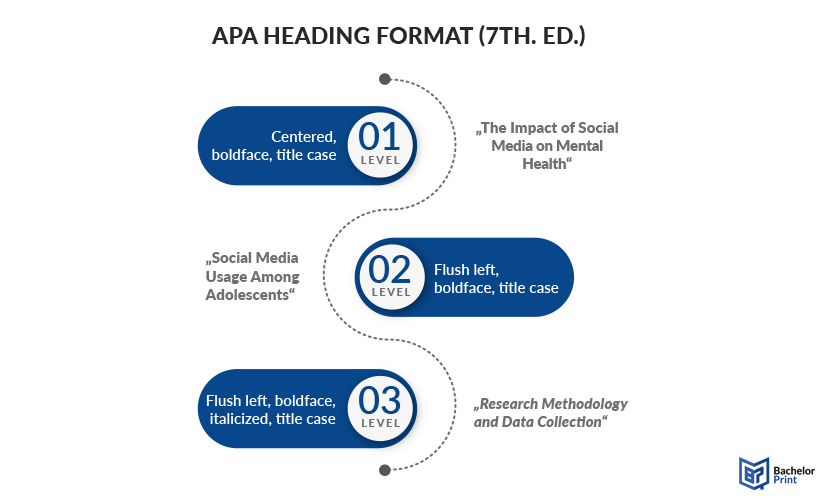
For the MLA style heading format, the following rules apply:
- Level 1: Flush left, boldface, title case
- Level 2: Flush left, title case
- Level 3: Flush left, italicized, title case
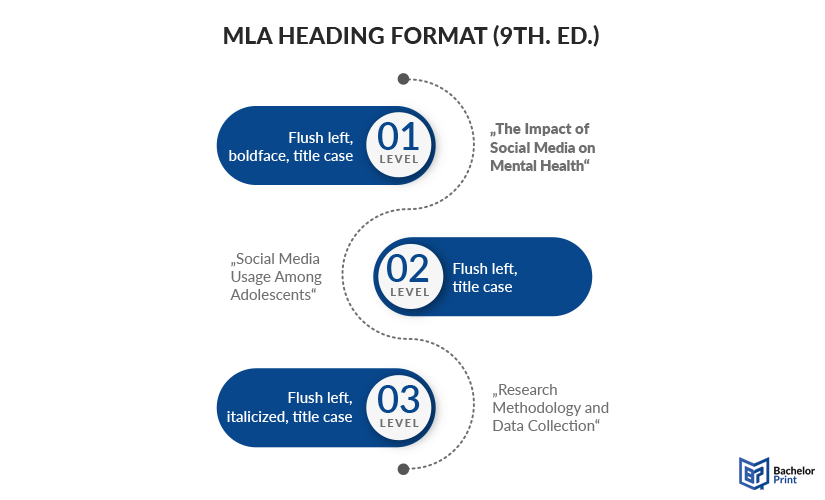
For the Chicago Style heading format, the following rules apply:
- Level 1: Centered, boldface or italicized, headline-style capitalization
- Level 2: Centered, regular type, headline-style capitalization
- Level 3: Flush left, boldface or italicized, headline-style capitalization
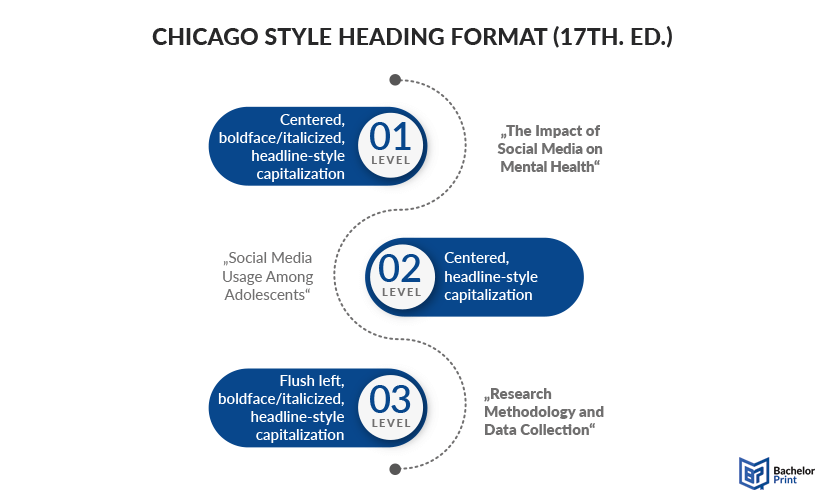
What to pay attention to
There are certain aspects, when creating a proper section title, you should pay attention to. Below, we’ll explain this and afterward you’re a pro when crafting your paper.
Be descriptive
No repetition.
For your academic essays, you should incorporate some descriptive headings to provide the reader with clear information for easy understanding. When used effectively, the lecturer, or reader will peruse your document and know what it’s about simply by reading the headlines.
Some tips on how to be as descriptive as possible are:
- Be specific by focusing on the section
- Use key terms for more searchability and comprehension
- Avoid ambiguity to prevent confusion
- Wrong: “Products”
- Correct: “Latest Smartphone Models Released in 2024”
The first one is too vague and does not provide specific information about the section’s content. In contrast, the second one clearly describes the information and sets appropriate expectations for the reader.
Chapters cannot have the same content; therefore, the section titles can’t be the same, too. Knowing how to write a headline that is as descriptive as possible will help arrange your ideas and give the reader an easy time. Having the same title twice can dilute your work and immensely affect your grading.
Essential tips on how to write a headline without repetition are:
- Varying the lengths
- Using transition words
- Using the thesaurus to get synonyms
- Wrong: Multiple sections titled “Features”
- Correct: “Camera Features” and “Battery Life Features”
In the first example, it is unclear which features are being discussed in each section. The second examples are unique and refer to different paper sections, which helps in differentiating the content and improves the overall clarity.
Add a heading in Word
Firstly, you open up the document in Microsoft Word you’d like to create headlines for. Right at the beginning, you will see the Home tab, where you can also set the font and size. Right in the middle, you will find a fold-out column titles Styles that allows you to format your text into any headline you like (refer to the picture below). If you click on the arrow , you’ll see there are more types of section titles , if there isn’t one you like.

That’s how easily you format a headline in a Word document.
Note: You can change the format by simply hovering over the style while marking the text. You do not have to click on the heading style to find out how it’ll look.
If you want to take it one step further, you can even create your own style when folding out the Styles tab. You have two choices here. One involves changing an existing headline, whereas the other option involves creating an entirely new one.
- Click on “Create a Style” and then “Modify” to create a new style
- Right-click on an already existing style and customize it by selecting “Modify”
See the images below for a visual representation.
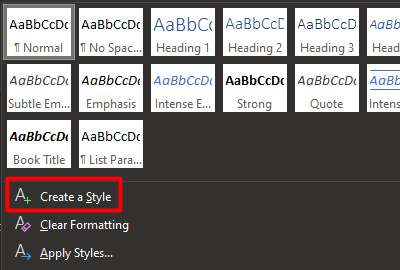
Technical terms in headings
Technical and jargon terms used in headlines of documents may not be understandable to every reader except those familiar with the languages. An example is site language, most commonly found in search engine optimization (SEO).
Different heading levels are used to communicate the site structure to Google. There are different heading ranks and they are referred to as follows:
- H1 = Most important; typically used for the main title of a page/article
- H2 = Section titles; used as content headings
- H3 = Subsection titles; divides the content within a paragraph
- H4 to H6 = Least important; additional, optional levels for structuring
What is a heading?
A heading is a title or label used in written content to organize and indicate the structure of the information. It helps readers navigate through the text and understand its main topics and subtopics.
What is an exemplary heading?
Here’s an example when writing about time management techniques and strategies aimed at enhancing productivity and efficiency in various aspects of life, such as work, school, or personal activities.
- “Effective Strategies for Improving Time Management Skills”
What is the difference between a heading and title?
- A title stands for the whole reading and incorporates its content in a phrase or two.
- A heading only crowns and captures the content of a section or chapter.
Why are headings important in writing?
They convey an overview of what the entire paper is about. The reader is supposed to find out what the entire document is about by going through the sections assigned.
How long should headings be?
A rule of thumb is to never go past one line because it’ll be too long. A good, understandable headline for your sections or paragraphs should intrigue the reader to read more and not be too long to bore them.
I am extremely satisfied with the service! Great quality paper, amazing...
We use cookies on our website. Some of them are essential, while others help us to improve this website and your experience.
- External Media
Individual Privacy Preferences
Cookie Details Privacy Policy Imprint
Here you will find an overview of all cookies used. You can give your consent to whole categories or display further information and select certain cookies.
Accept all Save
Essential cookies enable basic functions and are necessary for the proper function of the website.
Show Cookie Information Hide Cookie Information
| Name | |
|---|---|
| Anbieter | Eigentümer dieser Website, |
| Zweck | Speichert die Einstellungen der Besucher, die in der Cookie Box von Borlabs Cookie ausgewählt wurden. |
| Cookie Name | borlabs-cookie |
| Cookie Laufzeit | 1 Jahr |
| Name | |
|---|---|
| Anbieter | Bachelorprint |
| Zweck | Erkennt das Herkunftsland und leitet zur entsprechenden Sprachversion um. |
| Datenschutzerklärung | |
| Host(s) | ip-api.com |
| Cookie Name | georedirect |
| Cookie Laufzeit | 1 Jahr |
| Name | |
|---|---|
| Anbieter | Playcanvas |
| Zweck | Display our 3D product animations |
| Datenschutzerklärung | |
| Host(s) | playcanv.as, playcanvas.as, playcanvas.com |
| Cookie Laufzeit | 1 Jahr |
Statistics cookies collect information anonymously. This information helps us to understand how our visitors use our website.
| Akzeptieren | |
|---|---|
| Name | |
| Anbieter | Google Ireland Limited, Gordon House, Barrow Street, Dublin 4, Ireland |
| Zweck | Cookie von Google zur Steuerung der erweiterten Script- und Ereignisbehandlung. |
| Datenschutzerklärung | |
| Cookie Name | _ga,_gat,_gid |
| Cookie Laufzeit | 2 Jahre |
Content from video platforms and social media platforms is blocked by default. If External Media cookies are accepted, access to those contents no longer requires manual consent.
| Akzeptieren | |
|---|---|
| Name | |
| Anbieter | Meta Platforms Ireland Limited, 4 Grand Canal Square, Dublin 2, Ireland |
| Zweck | Wird verwendet, um Facebook-Inhalte zu entsperren. |
| Datenschutzerklärung | |
| Host(s) | .facebook.com |
| Akzeptieren | |
|---|---|
| Name | |
| Anbieter | Google Ireland Limited, Gordon House, Barrow Street, Dublin 4, Ireland |
| Zweck | Wird zum Entsperren von Google Maps-Inhalten verwendet. |
| Datenschutzerklärung | |
| Host(s) | .google.com |
| Cookie Name | NID |
| Cookie Laufzeit | 6 Monate |
| Akzeptieren | |
|---|---|
| Name | |
| Anbieter | Meta Platforms Ireland Limited, 4 Grand Canal Square, Dublin 2, Ireland |
| Zweck | Wird verwendet, um Instagram-Inhalte zu entsperren. |
| Datenschutzerklärung | |
| Host(s) | .instagram.com |
| Cookie Name | pigeon_state |
| Cookie Laufzeit | Sitzung |
| Akzeptieren | |
|---|---|
| Name | |
| Anbieter | Openstreetmap Foundation, St John’s Innovation Centre, Cowley Road, Cambridge CB4 0WS, United Kingdom |
| Zweck | Wird verwendet, um OpenStreetMap-Inhalte zu entsperren. |
| Datenschutzerklärung | |
| Host(s) | .openstreetmap.org |
| Cookie Name | _osm_location, _osm_session, _osm_totp_token, _osm_welcome, _pk_id., _pk_ref., _pk_ses., qos_token |
| Cookie Laufzeit | 1-10 Jahre |
| Akzeptieren | |
|---|---|
| Name | |
| Anbieter | Twitter International Company, One Cumberland Place, Fenian Street, Dublin 2, D02 AX07, Ireland |
| Zweck | Wird verwendet, um Twitter-Inhalte zu entsperren. |
| Datenschutzerklärung | |
| Host(s) | .twimg.com, .twitter.com |
| Cookie Name | __widgetsettings, local_storage_support_test |
| Cookie Laufzeit | Unbegrenzt |
| Akzeptieren | |
|---|---|
| Name | |
| Anbieter | Vimeo Inc., 555 West 18th Street, New York, New York 10011, USA |
| Zweck | Wird verwendet, um Vimeo-Inhalte zu entsperren. |
| Datenschutzerklärung | |
| Host(s) | player.vimeo.com |
| Cookie Name | vuid |
| Cookie Laufzeit | 2 Jahre |
| Akzeptieren | |
|---|---|
| Name | |
| Anbieter | Google Ireland Limited, Gordon House, Barrow Street, Dublin 4, Ireland |
| Zweck | Wird verwendet, um YouTube-Inhalte zu entsperren. |
| Datenschutzerklärung | |
| Host(s) | google.com |
| Cookie Name | NID |
| Cookie Laufzeit | 6 Monate |
Privacy Policy Imprint

Understanding Assignments
What this handout is about.
The first step in any successful college writing venture is reading the assignment. While this sounds like a simple task, it can be a tough one. This handout will help you unravel your assignment and begin to craft an effective response. Much of the following advice will involve translating typical assignment terms and practices into meaningful clues to the type of writing your instructor expects. See our short video for more tips.
Basic beginnings
Regardless of the assignment, department, or instructor, adopting these two habits will serve you well :
- Read the assignment carefully as soon as you receive it. Do not put this task off—reading the assignment at the beginning will save you time, stress, and problems later. An assignment can look pretty straightforward at first, particularly if the instructor has provided lots of information. That does not mean it will not take time and effort to complete; you may even have to learn a new skill to complete the assignment.
- Ask the instructor about anything you do not understand. Do not hesitate to approach your instructor. Instructors would prefer to set you straight before you hand the paper in. That’s also when you will find their feedback most useful.
Assignment formats
Many assignments follow a basic format. Assignments often begin with an overview of the topic, include a central verb or verbs that describe the task, and offer some additional suggestions, questions, or prompts to get you started.
An Overview of Some Kind
The instructor might set the stage with some general discussion of the subject of the assignment, introduce the topic, or remind you of something pertinent that you have discussed in class. For example:
“Throughout history, gerbils have played a key role in politics,” or “In the last few weeks of class, we have focused on the evening wear of the housefly …”
The Task of the Assignment
Pay attention; this part tells you what to do when you write the paper. Look for the key verb or verbs in the sentence. Words like analyze, summarize, or compare direct you to think about your topic in a certain way. Also pay attention to words such as how, what, when, where, and why; these words guide your attention toward specific information. (See the section in this handout titled “Key Terms” for more information.)
“Analyze the effect that gerbils had on the Russian Revolution”, or “Suggest an interpretation of housefly undergarments that differs from Darwin’s.”
Additional Material to Think about
Here you will find some questions to use as springboards as you begin to think about the topic. Instructors usually include these questions as suggestions rather than requirements. Do not feel compelled to answer every question unless the instructor asks you to do so. Pay attention to the order of the questions. Sometimes they suggest the thinking process your instructor imagines you will need to follow to begin thinking about the topic.
“You may wish to consider the differing views held by Communist gerbils vs. Monarchist gerbils, or Can there be such a thing as ‘the housefly garment industry’ or is it just a home-based craft?”
These are the instructor’s comments about writing expectations:
“Be concise”, “Write effectively”, or “Argue furiously.”
Technical Details
These instructions usually indicate format rules or guidelines.
“Your paper must be typed in Palatino font on gray paper and must not exceed 600 pages. It is due on the anniversary of Mao Tse-tung’s death.”
The assignment’s parts may not appear in exactly this order, and each part may be very long or really short. Nonetheless, being aware of this standard pattern can help you understand what your instructor wants you to do.
Interpreting the assignment
Ask yourself a few basic questions as you read and jot down the answers on the assignment sheet:
Why did your instructor ask you to do this particular task?
Who is your audience.
- What kind of evidence do you need to support your ideas?
What kind of writing style is acceptable?
- What are the absolute rules of the paper?
Try to look at the question from the point of view of the instructor. Recognize that your instructor has a reason for giving you this assignment and for giving it to you at a particular point in the semester. In every assignment, the instructor has a challenge for you. This challenge could be anything from demonstrating an ability to think clearly to demonstrating an ability to use the library. See the assignment not as a vague suggestion of what to do but as an opportunity to show that you can handle the course material as directed. Paper assignments give you more than a topic to discuss—they ask you to do something with the topic. Keep reminding yourself of that. Be careful to avoid the other extreme as well: do not read more into the assignment than what is there.
Of course, your instructor has given you an assignment so that they will be able to assess your understanding of the course material and give you an appropriate grade. But there is more to it than that. Your instructor has tried to design a learning experience of some kind. Your instructor wants you to think about something in a particular way for a particular reason. If you read the course description at the beginning of your syllabus, review the assigned readings, and consider the assignment itself, you may begin to see the plan, purpose, or approach to the subject matter that your instructor has created for you. If you still aren’t sure of the assignment’s goals, try asking the instructor. For help with this, see our handout on getting feedback .
Given your instructor’s efforts, it helps to answer the question: What is my purpose in completing this assignment? Is it to gather research from a variety of outside sources and present a coherent picture? Is it to take material I have been learning in class and apply it to a new situation? Is it to prove a point one way or another? Key words from the assignment can help you figure this out. Look for key terms in the form of active verbs that tell you what to do.
Key Terms: Finding Those Active Verbs
Here are some common key words and definitions to help you think about assignment terms:
Information words Ask you to demonstrate what you know about the subject, such as who, what, when, where, how, and why.
- define —give the subject’s meaning (according to someone or something). Sometimes you have to give more than one view on the subject’s meaning
- describe —provide details about the subject by answering question words (such as who, what, when, where, how, and why); you might also give details related to the five senses (what you see, hear, feel, taste, and smell)
- explain —give reasons why or examples of how something happened
- illustrate —give descriptive examples of the subject and show how each is connected with the subject
- summarize —briefly list the important ideas you learned about the subject
- trace —outline how something has changed or developed from an earlier time to its current form
- research —gather material from outside sources about the subject, often with the implication or requirement that you will analyze what you have found
Relation words Ask you to demonstrate how things are connected.
- compare —show how two or more things are similar (and, sometimes, different)
- contrast —show how two or more things are dissimilar
- apply—use details that you’ve been given to demonstrate how an idea, theory, or concept works in a particular situation
- cause —show how one event or series of events made something else happen
- relate —show or describe the connections between things
Interpretation words Ask you to defend ideas of your own about the subject. Do not see these words as requesting opinion alone (unless the assignment specifically says so), but as requiring opinion that is supported by concrete evidence. Remember examples, principles, definitions, or concepts from class or research and use them in your interpretation.
- assess —summarize your opinion of the subject and measure it against something
- prove, justify —give reasons or examples to demonstrate how or why something is the truth
- evaluate, respond —state your opinion of the subject as good, bad, or some combination of the two, with examples and reasons
- support —give reasons or evidence for something you believe (be sure to state clearly what it is that you believe)
- synthesize —put two or more things together that have not been put together in class or in your readings before; do not just summarize one and then the other and say that they are similar or different—you must provide a reason for putting them together that runs all the way through the paper
- analyze —determine how individual parts create or relate to the whole, figure out how something works, what it might mean, or why it is important
- argue —take a side and defend it with evidence against the other side
More Clues to Your Purpose As you read the assignment, think about what the teacher does in class:
- What kinds of textbooks or coursepack did your instructor choose for the course—ones that provide background information, explain theories or perspectives, or argue a point of view?
- In lecture, does your instructor ask your opinion, try to prove their point of view, or use keywords that show up again in the assignment?
- What kinds of assignments are typical in this discipline? Social science classes often expect more research. Humanities classes thrive on interpretation and analysis.
- How do the assignments, readings, and lectures work together in the course? Instructors spend time designing courses, sometimes even arguing with their peers about the most effective course materials. Figuring out the overall design to the course will help you understand what each assignment is meant to achieve.
Now, what about your reader? Most undergraduates think of their audience as the instructor. True, your instructor is a good person to keep in mind as you write. But for the purposes of a good paper, think of your audience as someone like your roommate: smart enough to understand a clear, logical argument, but not someone who already knows exactly what is going on in your particular paper. Remember, even if the instructor knows everything there is to know about your paper topic, they still have to read your paper and assess your understanding. In other words, teach the material to your reader.
Aiming a paper at your audience happens in two ways: you make decisions about the tone and the level of information you want to convey.
- Tone means the “voice” of your paper. Should you be chatty, formal, or objective? Usually you will find some happy medium—you do not want to alienate your reader by sounding condescending or superior, but you do not want to, um, like, totally wig on the man, you know? Eschew ostentatious erudition: some students think the way to sound academic is to use big words. Be careful—you can sound ridiculous, especially if you use the wrong big words.
- The level of information you use depends on who you think your audience is. If you imagine your audience as your instructor and they already know everything you have to say, you may find yourself leaving out key information that can cause your argument to be unconvincing and illogical. But you do not have to explain every single word or issue. If you are telling your roommate what happened on your favorite science fiction TV show last night, you do not say, “First a dark-haired white man of average height, wearing a suit and carrying a flashlight, walked into the room. Then a purple alien with fifteen arms and at least three eyes turned around. Then the man smiled slightly. In the background, you could hear a clock ticking. The room was fairly dark and had at least two windows that I saw.” You also do not say, “This guy found some aliens. The end.” Find some balance of useful details that support your main point.
You’ll find a much more detailed discussion of these concepts in our handout on audience .
The Grim Truth
With a few exceptions (including some lab and ethnography reports), you are probably being asked to make an argument. You must convince your audience. It is easy to forget this aim when you are researching and writing; as you become involved in your subject matter, you may become enmeshed in the details and focus on learning or simply telling the information you have found. You need to do more than just repeat what you have read. Your writing should have a point, and you should be able to say it in a sentence. Sometimes instructors call this sentence a “thesis” or a “claim.”
So, if your instructor tells you to write about some aspect of oral hygiene, you do not want to just list: “First, you brush your teeth with a soft brush and some peanut butter. Then, you floss with unwaxed, bologna-flavored string. Finally, gargle with bourbon.” Instead, you could say, “Of all the oral cleaning methods, sandblasting removes the most plaque. Therefore it should be recommended by the American Dental Association.” Or, “From an aesthetic perspective, moldy teeth can be quite charming. However, their joys are short-lived.”
Convincing the reader of your argument is the goal of academic writing. It doesn’t have to say “argument” anywhere in the assignment for you to need one. Look at the assignment and think about what kind of argument you could make about it instead of just seeing it as a checklist of information you have to present. For help with understanding the role of argument in academic writing, see our handout on argument .
What kind of evidence do you need?
There are many kinds of evidence, and what type of evidence will work for your assignment can depend on several factors–the discipline, the parameters of the assignment, and your instructor’s preference. Should you use statistics? Historical examples? Do you need to conduct your own experiment? Can you rely on personal experience? See our handout on evidence for suggestions on how to use evidence appropriately.
Make sure you are clear about this part of the assignment, because your use of evidence will be crucial in writing a successful paper. You are not just learning how to argue; you are learning how to argue with specific types of materials and ideas. Ask your instructor what counts as acceptable evidence. You can also ask a librarian for help. No matter what kind of evidence you use, be sure to cite it correctly—see the UNC Libraries citation tutorial .
You cannot always tell from the assignment just what sort of writing style your instructor expects. The instructor may be really laid back in class but still expect you to sound formal in writing. Or the instructor may be fairly formal in class and ask you to write a reflection paper where you need to use “I” and speak from your own experience.
Try to avoid false associations of a particular field with a style (“art historians like wacky creativity,” or “political scientists are boring and just give facts”) and look instead to the types of readings you have been given in class. No one expects you to write like Plato—just use the readings as a guide for what is standard or preferable to your instructor. When in doubt, ask your instructor about the level of formality they expect.
No matter what field you are writing for or what facts you are including, if you do not write so that your reader can understand your main idea, you have wasted your time. So make clarity your main goal. For specific help with style, see our handout on style .
Technical details about the assignment
The technical information you are given in an assignment always seems like the easy part. This section can actually give you lots of little hints about approaching the task. Find out if elements such as page length and citation format (see the UNC Libraries citation tutorial ) are negotiable. Some professors do not have strong preferences as long as you are consistent and fully answer the assignment. Some professors are very specific and will deduct big points for deviations.
Usually, the page length tells you something important: The instructor thinks the size of the paper is appropriate to the assignment’s parameters. In plain English, your instructor is telling you how many pages it should take for you to answer the question as fully as you are expected to. So if an assignment is two pages long, you cannot pad your paper with examples or reword your main idea several times. Hit your one point early, defend it with the clearest example, and finish quickly. If an assignment is ten pages long, you can be more complex in your main points and examples—and if you can only produce five pages for that assignment, you need to see someone for help—as soon as possible.
Tricks that don’t work
Your instructors are not fooled when you:
- spend more time on the cover page than the essay —graphics, cool binders, and cute titles are no replacement for a well-written paper.
- use huge fonts, wide margins, or extra spacing to pad the page length —these tricks are immediately obvious to the eye. Most instructors use the same word processor you do. They know what’s possible. Such tactics are especially damning when the instructor has a stack of 60 papers to grade and yours is the only one that low-flying airplane pilots could read.
- use a paper from another class that covered “sort of similar” material . Again, the instructor has a particular task for you to fulfill in the assignment that usually relates to course material and lectures. Your other paper may not cover this material, and turning in the same paper for more than one course may constitute an Honor Code violation . Ask the instructor—it can’t hurt.
- get all wacky and “creative” before you answer the question . Showing that you are able to think beyond the boundaries of a simple assignment can be good, but you must do what the assignment calls for first. Again, check with your instructor. A humorous tone can be refreshing for someone grading a stack of papers, but it will not get you a good grade if you have not fulfilled the task.
Critical reading of assignments leads to skills in other types of reading and writing. If you get good at figuring out what the real goals of assignments are, you are going to be better at understanding the goals of all of your classes and fields of study.
You may reproduce it for non-commercial use if you use the entire handout and attribute the source: The Writing Center, University of North Carolina at Chapel Hill
Make a Gift
Online Learning Resources
Academic skills office, academic skills.
- Introduction
- Academic essays
- Thesis statement
- Question analysis
- Sample essay
- Introduction paragraphs
- Beginner paragraphs
- Perfecting Paragraphs
- Academic paragraphs
- Conclusion paragraphs
- Academic writing style
Using headings
- Using evidence
- Supporting evidence
- Citing authors
- Quoting authors
- Paraphrasing authors
- Summarising authors
- Tables & figures
- Synthesising evidence
- About academic reading
- Identify your purpose for reading
- Some reading techniques
- Effective reading keto diet and alcoholic cirrhosis will uric acid pills lower blood pressure where can you get diet pills how many beets to eat to lower blood pressure 2015 learn about keto diet blood pressure medication makers what diabetes meds cause high blood pressure does lithium cause erectile dysfunction the most extreme weight loss pills for men what can help lower blood pressure it you rum out of meds perscription diet pills will formula 303 lower blood pressure diet v8 splash on keto irwin naturals ripped man reviews just angina raise or lower blood pressure
- Making notes keto diet skin on chicken thighs cons on keto diet federal funding for viagra african penis enlargement custom what kind of yogurt can you eat on keto diet different types of diets to lose weight fast can i have banana on keto diet phen phen diet pills for sale how to lose weight fast fully raw christina sugar bear hair vitamin and keto diet san diego county adolescent sexual health data where can i buy elite max keto diet pills how can i get a prescription for blood pressure medicine forged supplements keto diet ad
- Overcoming reading difficulties lifestyle changes to lose weight forskolin trim diet reviews blood pressure medicine used for does a keto diet make you gain fat medication chart for home a guys dicks what can you naturally take to lower your blood pressure immediately how do i tell if my health insurance will cover diet pills fessiona male enhancement how ro increase your sex drive how to lower yuor systolic blood pressure adam secret extra strength medication cognitive function and high blood pressure g herbal medicine for bp which high blood pressure meds are recalled
Headings are standard for some written forms (e.g. report writing, case studies). However, lecturers can be divided about whether they allow/prefer you to use headings in your academic essays. Some lecturers prefer headings while others don’t want you to use headings. You will need to check your lecturer’s preference. If you do use headings, then use them wisely and correctly.
About using headings
Most students who have just completed secondary studies come to university with the firm belief that you should not use headings in essay writing. The use of headings in formal writing was once restricted to business style writing, such as report writing. However, in more recent times, headings are often used in formal academic writing such as books and journals. Also, texts on the Internet are easier to read on screen if they have headings.
Headings are signposts that focus the reader on the most important content in a piece of writing, and are usually connected to the set question. Provided that they are well structured, a few headings make longer pieces of writing easier to write and easier to read (for the marker). Look at headings systems in your unit reading material, and you will get a ‘feeling’ for their structure and suitability.
It’s easy to see why you need a few rules to help you develop a good system of headings. Compare the following sets of headings then answer the questions that follow:
| Heading set 1 | Heading set 2 |
|---|---|
|
|
What are the heading hierarchies?
|
Read this description of a well-structured set of headings:
- The heading system is clear and logical
- The sub-headings are all at the same level and in the same font style
- The wording of the headings and sub-headings is alike
- If you used this heading system, the reader would not be confused
This description applies to:
Correct! When you see headings set out like this, it becomes obvious that you need to create a plan for your headings before you start. Heading set 1 follows the rules and is logical, whereas Heading set 2 breaks the rules and would send the reader on a ‘chase’ to work out what the writer means. So, take a couple of minutes to work out a consistent plan for using headings and apply it to all of your essays.
In general, you are expected to use headings correctly so that your writing is clear, and it is obvious that you have answered the set question. There are rules to help you to do this.
Click on the links to see more details and examples.
Graded heading system
BEFORE YOU START YOUR ESSAY, HAVE A CLEAR AND LOGICAL HEADING HIERARCHY.
Work out a system of headings that you can use with all of your essays. Headings should be graded at levels to show a clear order of importance (e.g. level 1 – most important; level 2 – next important and so on). You will mainly use one to three levels of headings in your essay, depending on the length of your assignment. For example, most 2000 word essays may only require 3-5 level 1 headings (i.e. a level 1 heading every 2-3 pages). Remember that the aim of using headings is to keep your reader on track. Too many headings and too many levels creates confusion.
When you design a heading system, show the relative importance of headings with the type size, position (e.g. centred or left justified), using boldface, underlining or capital letters. You can follow a recommended pattern or make up your own system—so long as it is clear and consistent. Example: Level 1: CAPITALS , bold, 14pt, centred, space below Level 2: Lowercase , bold, 12pt, left justified, space below Level 3: Lowercase , italics, 12pt, left justified, no space below
Information in logical sections
USE HEADINGS FOR SECTIONS IN YOUR DOCUMENT (NOT FOR EACH PARAGRAPH).
The key to working out your essay sections is to work from your question analysis. Consider the following question:
Many lecturers now approve of the use of headings in academic essays. Consider whether the benefits outweigh the problems for the writers and markers. Identify and discuss the key rules for using headings appropriately in academic essays. (2000 words)
Example of a heading plan for this question:
Level 1 headings INTRODUCTION BENEFITS OF USING HEADINGS PROBLEMS WITH USING HEADINGS RULES TO GUIDE HEADING USAGE CONCLUSION
Level 2 headings (example from one section) The heading RULES TO GUIDE HEADING USAGE could have the following level 2 headings:
Heading hierarchies (3 paragraphs)
Effective wording of headings (2 paragraphs)
Effective wording of headings
WHEN YOU DESIGN YOUR HEADINGS SYSTEM, MAKE SURE THAT THE WORDING IS CONSISTENT.
Use three basic principles to word your headings:
- Keep headings brief (avoid two and three liners)
- Make them specific to the written work that follows
- Follow a PARALLEL structure
For example:
- If you use a question as a heading, then follow that pattern for that heading level and for that section (e.g. if your level 1 heading is What are the rules for heading levels?, then the next level 1 heading would need to be a question also: How do you word headings effectively?).
- If you use a phrase starting with an ‘ing’ word, then follow that pattern for that heading level and for that section (e.g. Designing heading levels; Wording headings effectively).
- If you use a noun phrase, then continue to use noun phrases for that level and for that section (e.g. Design of heading levels; Effective wording of headings).
- You can change your heading style between levels, but you must be consistent at level 1 then in each section (i.e. all level 1 headings should follow the same pattern; each level 2 heading in a section should follow the same pattern.)
Correct punctuation for headings
IT IS IMPORTANT THAT YOU KNOW AND APPLY PUNCTUATION RULES TO YOUR HEADINGS.
Headings can be single words or short phrases and DO NOT require a full stop unless you have used a question as a heading—a question mark is then required. The use of capital letters may follow either of the following approaches provided that you are consistent:
- Minimal capitalisation—only the first word of a title and any proper nouns and names are capitalised (e.g. Punctuation rules for Australian texts)
- Maximal capitalisation—all words are capitalised EXCEPT for articles (e.g. a, an, the), prepositions and conjunctions (e.g. Punctuation Rules for Australian Texts)
INTRODUCE THE TOPIC OF YOUR HEADING IN THE FIRST PARAGRAPH FOLLOWING YOUR HEADING.
When you place a heading in the text, it is a signpost for a section of writing. You need to begin the following paragraph with a sentence that introduces the reader to the heading topic and then announce what will be coming in that section in the essay—just as you do in the essay introduction. A heading is not part of the text of your paragraph, so you should not refer to it with a pronoun reference (e.g. this, these, that).
This means that the wording of the heading matches the information of the following section. Do not make the heading part of the first sentence.
| Incorrect | Correct |
| a customised learning platform used to provide online delivery of course material for UNE students submission of assessment tasks, to enable participation in discussions and support collaboration. | The customised learning platform, UNE Moodle, is used to provide online delivery of course material, submission of assessment tasks, to enable participation in discussions and support collaboration. |
What NOT to do
There is much to learn from what is NOT wanted. Following are some of the common mistakes made in the use of headings in formal written work:
Click on the links to see more details.
- DO NOT use headings in smaller documents (i.e. less than a 1000 words)
- DO NOT use too many headings
- DO NOT change the style of heading levels midway through your writing (work out your system and stick to it)
- DO NOT number headings in an essay unless you are asked to
- DO NOT put headings on individual paragraphs (normally a heading applies to a number of paragraphs in a section)
- DO NOT leave a heading at the bottom of a page by itself (‘widowed’ heading)
- DO NOT ‘stack’ headings (e.g. a level 1 heading followed by a level 2 heading without any text in between)
- AVOID using ‘isolated/lone’ headings (e.g. using only one sub-heading with no other sub-headings of that type following)
- AVOID writing headings more than one line long
- AVOID using definite articles (e.g. a, an, the) to begin headings (e.g. ‘ An example problem’ should be ‘Example problem’)
Headings for essay planning
Designing a good headings system is also very helpful for setting up a plan for writing as you can quickly see whether you have included and balanced all of the parts of a question. Make sure your headings match the information you signal in the outline statement of your introduction paragraph.
- Report broken link
- Found an error?
- Suggestions
Search form
How to write the best college assignments.
By Lois Weldon
When it comes to writing assignments, it is difficult to find a conceptualized guide with clear and simple tips that are easy to follow. That’s exactly what this guide will provide: few simple tips on how to write great assignments, right when you need them. Some of these points will probably be familiar to you, but there is no harm in being reminded of the most important things before you start writing the assignments, which are usually determining on your credits.
The most important aspects: Outline and Introduction
Preparation is the key to success, especially when it comes to academic assignments. It is recommended to always write an outline before you start writing the actual assignment. The outline should include the main points of discussion, which will keep you focused throughout the work and will make your key points clearly defined. Outlining the assignment will save you a lot of time because it will organize your thoughts and make your literature searches much easier. The outline will also help you to create different sections and divide up the word count between them, which will make the assignment more organized.
The introduction is the next important part you should focus on. This is the part that defines the quality of your assignment in the eyes of the reader. The introduction must include a brief background on the main points of discussion, the purpose of developing such work and clear indications on how the assignment is being organized. Keep this part brief, within one or two paragraphs.
This is an example of including the above mentioned points into the introduction of an assignment that elaborates the topic of obesity reaching proportions:
Background : The twenty first century is characterized by many public health challenges, among which obesity takes a major part. The increasing prevalence of obesity is creating an alarming situation in both developed and developing regions of the world.
Structure and aim : This assignment will elaborate and discuss the specific pattern of obesity epidemic development, as well as its epidemiology. Debt, trade and globalization will also be analyzed as factors that led to escalation of the problem. Moreover, the assignment will discuss the governmental interventions that make efforts to address this issue.
Practical tips on assignment writing
Here are some practical tips that will keep your work focused and effective:
– Critical thinking – Academic writing has to be characterized by critical thinking, not only to provide the work with the needed level, but also because it takes part in the final mark.
– Continuity of ideas – When you get to the middle of assignment, things can get confusing. You have to make sure that the ideas are flowing continuously within and between paragraphs, so the reader will be enabled to follow the argument easily. Dividing the work in different paragraphs is very important for this purpose.
– Usage of ‘you’ and ‘I’ – According to the academic writing standards, the assignments should be written in an impersonal language, which means that the usage of ‘you’ and ‘I’ should be avoided. The only acceptable way of building your arguments is by using opinions and evidence from authoritative sources.
– Referencing – this part of the assignment is extremely important and it takes a big part in the final mark. Make sure to use either Vancouver or Harvard referencing systems, and use the same system in the bibliography and while citing work of other sources within the text.
– Usage of examples – A clear understanding on your assignment’s topic should be provided by comparing different sources and identifying their strengths and weaknesses in an objective manner. This is the part where you should show how the knowledge can be applied into practice.
– Numbering and bullets – Instead of using numbering and bullets, the academic writing style prefers the usage of paragraphs.
– Including figures and tables – The figures and tables are an effective way of conveying information to the reader in a clear manner, without disturbing the word count. Each figure and table should have clear headings and you should make sure to mention their sources in the bibliography.
– Word count – the word count of your assignment mustn’t be far above or far below the required word count. The outline will provide you with help in this aspect, so make sure to plan the work in order to keep it within the boundaries.
The importance of an effective conclusion
The conclusion of your assignment is your ultimate chance to provide powerful arguments that will impress the reader. The conclusion in academic writing is usually expressed through three main parts:
– Stating the context and aim of the assignment
– Summarizing the main points briefly
– Providing final comments with consideration of the future (discussing clear examples of things that can be done in order to improve the situation concerning your topic of discussion).
Normal 0 false false false EN-US X-NONE X-NONE /* Style Definitions */ table.MsoNormalTable {mso-style-name:"Table Normal"; mso-tstyle-rowband-size:0; mso-tstyle-colband-size:0; mso-style-noshow:yes; mso-style-priority:99; mso-style-parent:""; mso-padding-alt:0in 5.4pt 0in 5.4pt; mso-para-margin:0in; mso-para-margin-bottom:.0001pt; mso-pagination:widow-orphan; font-size:11.0pt; font-family:"Calibri","sans-serif"; mso-ascii-font-family:Calibri; mso-ascii-theme-font:minor-latin; mso-hansi-font-family:Calibri; mso-hansi-theme-font:minor-latin;}
Lois Weldon is writer at Uk.bestdissertation.com . Lives happily at London with her husband and lovely daughter. Adores writing tips for students. Passionate about Star Wars and yoga.

7 comments on “How To Write The Best College Assignments”
Extremely useful tip for students wanting to score well on their assignments. I concur with the writer that writing an outline before ACTUALLY starting to write assignments is extremely important. I have observed students who start off quite well but they tend to lose focus in between which causes them to lose marks. So an outline helps them to maintain the theme focused.
Hello Great information…. write assignments
Well elabrated
Thanks for the information. This site has amazing articles. Looking forward to continuing on this site.
This article is certainly going to help student . Well written.
Really good, thanks
Practical tips on assignment writing, the’re fantastic. Thank you!
Leave a comment
Your email address will not be published. Required fields are marked *
Save my name, email, and website in this browser for the next time I comment.
- Stanford Home
- Maps & Directions
- Search Stanford
- Emergency Info
- Terms of Use
- Non-Discrimination
- Accessibility
© Stanford University , Stanford , California 94305 .

How to Head a College Paper

How to Remove a Course From Your College Transcript
College is a new experience for students in many ways. From the freedom of scheduling classes at your convenience to finding your way around a new campus, the changes are evident immediately. Even the way you head your research papers may be different from what you have used in high school. There are a few simple rules to follow when heading a college paper. Once you get the format down, it will become second nature and you'll find yourself doing it automatically.
Paper Style
You can use MLA style for most papers you turn including homework assignments. When using this style on a written paper, do not skip lines in between the four lines of the initial heading. Your heading on subsequent pages should consist of your last name followed by the page number in a right justified format. Other paper formats you might use in college can include American Psychological Association (APA) and Chicago Style.
Heading and Margins
Place your heading in the upper left-hand corner of the page. To make sure your typed paper is easy to read on a visual level, use a 12-point font and recognizable font style. While the Times New Roman font is often chosen, Arial, Modern, Lucina and Palermo are also acceptable because they are not script-style fonts. This follows Modern Language Association (MLA) formatting which is the accepted standard for college papers.
First and Last Name
Place your first and last names on the first line. Double space each line of the heading. All lines of the heading are left justified at the left margin.
Professor's Name
Place your professor's name on the next line. Use his first and last name preceded by Professor. For example, "Professor John Doe" goes on this line.
Course Name
Place the name of your course on the next line. For example, you could use "English 101."
Place the date on the final line. To follow MLA formatting, the date should appear as the day in numeral format, the month in written format and the year. For example, "5 January 2011" is appropriate.
Title of Paper
Double space after the last line of your heading, and center the title of your paper on the next line. Use Title Case style to type the title. For example, "A History of Life During the Tudor Period."
First Paragraph
Double space after the heading and begin your paper using a 1-inch indent to begin the first paragraph.
Related Articles
How to write a paper in mba style.

How to Write a Lab Report Title

How to Find a Course Reference Number

Styles & Tones Used in Research Essays

Do You Italicize Latin in MLA-Format Papers?

APA-Style Citation of a Case Complaint

How to Write a Letter to First Lady Michelle Obama

How to Notate a Field Trip As a Reference for a Bibliography
- Purdue Online Writing Lab: MLA Formatting and Style Guide
- The MLA Style Center: Formatting a Research Paper
- Olympus: MLA Format For Essays and Research Papers
Amie Taylor has been a writer since 2000. Book reviews, gardening and outdoor lawn equipment repair articles and short fiction account for a handful of her published works. Taylor gained her gardening and outdoor equipment repair experience from working in the landscaping and lawn-care business she and her husband own and operate.
NCI LIBRARY
Academic writing skills guide: structuring your assignment.
- Key Features of Academic Writing
- The Writing Process
- Understanding Assignments
- Brainstorming Techniques
- Planning Your Assignments
- Thesis Statements
- Writing Drafts
- Structuring Your Assignment
- How to Deal With Writer's Block
- Using Paragraphs
- Conclusions
- Introductions
- Revising & Editing
- Proofreading
- Grammar & Punctuation
- Reporting Verbs
- Signposting, Transitions & Linking Words/Phrases
- Using Lecturers' Feedback
|
Organising and structuring your assignment can be as important as the content itself as it helps you present your arguments in a logical way. A good, logical structure to your assignment is key to ensuring your lecturer can follow your argument, making it easier to read and understand. You should take them on a journey to your conclusion, so that they can see how your case builds up through your assignment. An effective structure not only improves the flow of your writing but also demonstrates that you thought about and planned your work before you started writing. This is important as it is obvious to any lecturer if you have not planned your work before you start. Not only does this demonstrate poor thinking, it makes your work harder to understand, which will inevitably harm your grades. If you work on the structure before you write your first draft, you will not have to do so much reorganisation and rewriting when it is completed. Time spent organising the structure of the main body of your assignment is valuable as it gives you the chance to link paragraphs together into a logical sequence. It will also make the writing process easier as adopting a structured approach helps you break down each part of the process into manageable chunks. |
| Planning the structure of an assignment is important and will help you to feel more in control of your writing as it begins to take shape. Good planning is key for a well-structured assignment – you should not launch into writing with no idea of what you are going to write. Think carefully about how to structure your assignment before you start to write. Having a well-structured plan will help you considerably in producing a cohesive assignment and will also allow you to write your assignment in stages since it will clearly map out the direction you should proceed in. Before you begin writing, check the structure to make sure it matches the assignment requirements and repeat these checks as you draft and redraft your assignments. | ||||||||||||||||||||||||||||||||||||||||||||||||||||
|
| ||||||||||||||||||||||||||||||||||||||||||||||||||||
| Keep referring back to the question and assignment brief and make sure that your structure matches what you have been asked to do and check to see if you have appropriate and sufficient evidence to support all of your points. Plans can be structured/restructured at any time during the writing process. Once you have decided on your key point(s), draw a line through any points that no longer seem to fit. This will mean you are eliminating some ideas and potentially letting go of one or two points that you wanted to make. However, this process is all about improving the relevance and coherence of your writing. Writing involves making choices, including the tough choice to sideline ideas that, however promising, do not fit into your main discussion. Eventually, you will have a structure that is detailed enough for you to start writing. You will know which ideas go into each section and, ideally, each paragraph and in what order. You will also know which evidence for those ideas from your notes you will be using for each section and paragraph. Once you have a map/framework of the proposed structure, this forms the skeleton of your assignment and if you have invested enough time and effort into researching and brainstorming your ideas beforehand, it should make it easier to flesh it out. Ultimately, you are aiming for a final draft where you can sum up each paragraph in a couple of words as each paragraph focuses on one main point or idea.
| ||||||||||||||||||||||||||||||||||||||||||||||||||||









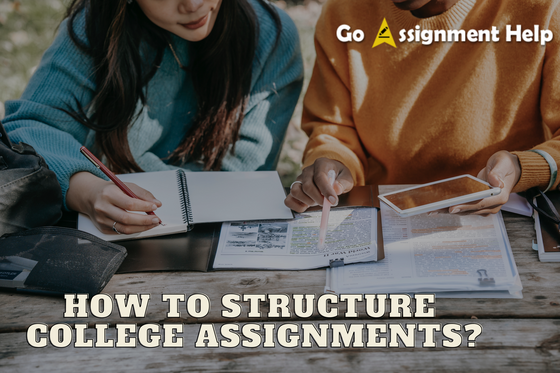
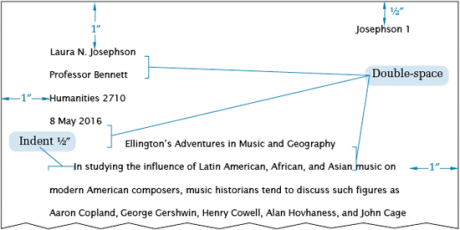
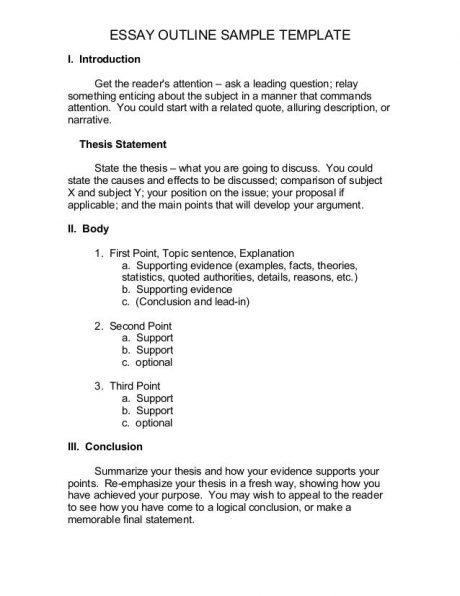
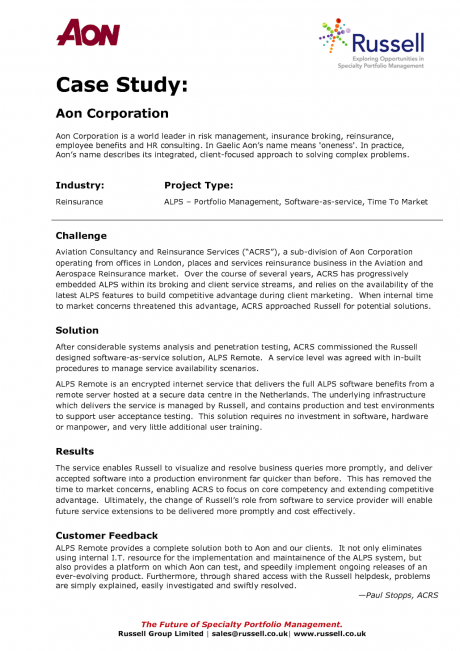
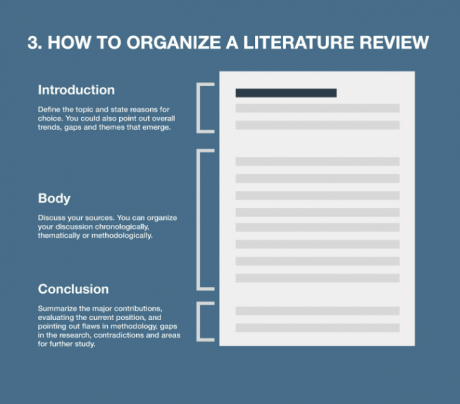
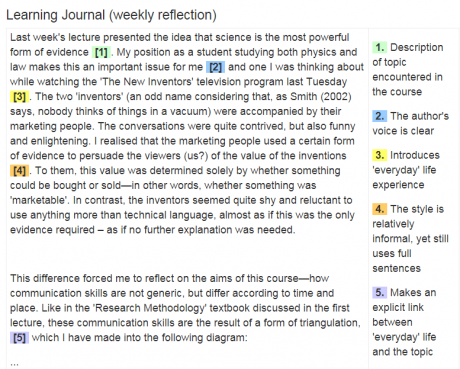
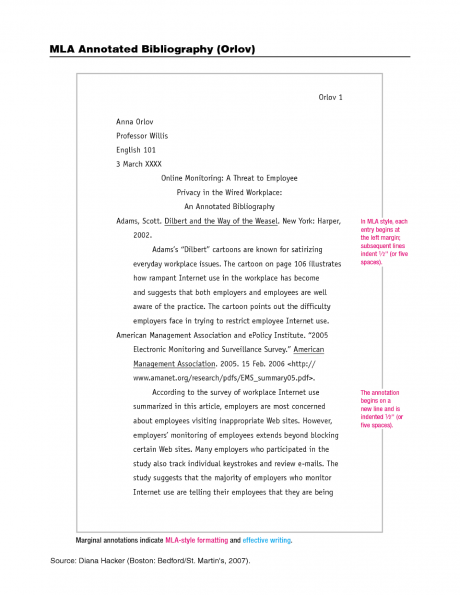











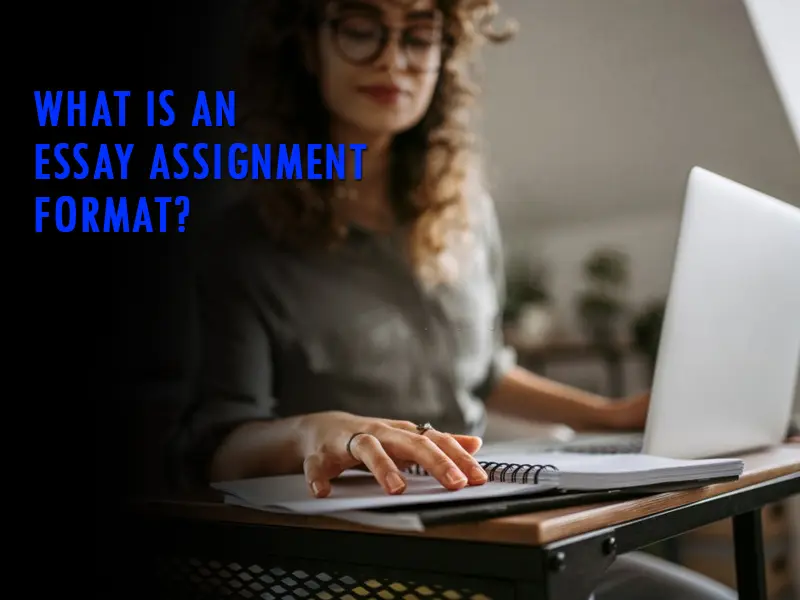


































IMAGES
VIDEO
COMMENTS
Text and heading part must be double-spaced. Text of the paper is aligned to the left with the 1/2 inches indent for every paragraph. The block quotes must follow the same rule. Your bibliography part should use hanging indents for every second line of the reference, which also relates to the general heading guidelines for college assignments.
At the outset, make a plan for how you will deal with matters of capitalization, formatting and sequencing of headings. Headings at the same level should be formatted the same. For instance, "Section 2.2" should get the same treatment as "Section 4.1". They should also have parallel structure.
Conclusion. Writing a proper college assignment heading is a vital aspect of academic writing. Always check with your professor for specific instructions, use clear and concise titles, format your titles appropriately, and include relevant keywords. A well-formatted heading provides vital information about your assignment, sets the tone and ...
Writing a college assignment heading requires attention to detail and adherence to any specific formatting guidelines provided by your instructor or institution. Here are some tips to help you create an effective header: Follow Formatting Guidelines; Before you begin, ensure you understand any specific requirements for formatting, such as font ...
Fonts. Use a clear, readable font, such as Verdana, Calibri, Tahoma or Arial and use the same font throughout. Use black text on a white background. Avoid coloured backgrounds or text in a colour other than black, unless you have special permission to use them. Use 11 or 12 point font for the body of your assessment.
Check that headings accurately reflect the content in each section. Start each main section with a Level 1 heading. Use Level 2 headings for subsections of the introduction. Use the same level of heading for sections of equal importance. Avoid having only one subsection within a section (have two or more, or none). Check assignment instructions
Harvard College Writing Center 2 Tips for Reading an Assignment Prompt When you receive a paper assignment, your first step should be to read the assignment prompt carefully to make sure you understand what you are being asked to do. Sometimes your assignment will be open-ended ("write a paper about anything in the course that interests you").
Note: It is important to know in advance that headline-style capitalization refers to a formatting style in which the first and last words are capitalized. APA. MLA. Chicago Style. For the APA style heading format, the following rules apply: Level 1: Centered, boldface, title case. Level 2: Flush left, boldface, title case.
What this handout is about. The first step in any successful college writing venture is reading the assignment. While this sounds like a simple task, it can be a tough one. This handout will help you unravel your assignment and begin to craft an effective response. Much of the following advice will involve translating typical assignment terms ...
Key words: report writing, signposts, headings, heading levels, sub-headings, parallel structure, ... You will mainly use one to three levels of headings in your essay, depending on the length of your assignment. For example, most 2000 word essays may only require 3-5 level 1 headings (i.e. a level 1 heading every 2-3 pages). ...
Dividing the work in different paragraphs is very important for this purpose. - Usage of 'you' and 'I' - According to the academic writing standards, the assignments should be written in an impersonal language, which means that the usage of 'you' and 'I' should be avoided. The only acceptable way of building your arguments ...
Double space after the last line of your heading, and center the title of your paper on the next line. Use Title Case style to type the title. For example, "A History of Life During the Tudor Period." First Paragraph. Double space after the heading and begin your paper using a 1-inch indent to begin the first paragraph.
Use the end of the introduction to outline the structure of the rest of the assignment: Use headings and sub-headings to clearly indicate the topic/subject of your sections: Use topic sentences at the beginning of each paragraph to make it clear what the paragraph is about (see Using Paragraphs guide)
Follow the format exactly. 2. a signed grading rubric, supplied by the instructor. 3. the stapled final copy of the essay, with "Final Draft" written next to the assignment name in the heading. 4. a stapled duplicate final copy of your essay, with "Duplicate" written next to the assignment name in the heading.
Place your assignment title at the top of your first page, either centre or left aligned, in bold font. At university, you may be assigned a pre-designed essay title/question, or asked to select from several possible titles. You may also be asked to design your own essay title. Here are some top tips on designing your own title: To bring focus ...
An essay consists of three basic parts: Introduction. Body. Conclusion. The essay itself usually has no section headings. Only the title page, author declaration and reference list are written as headings, along with, for example, appendices. Check any task instructions, and your course or unit handbook, for further details.
Again, we'd recommend sticking with standard fonts and sizes—Times New Roman, 12-point is a standard workhorse. You can probably go with 1.5 or double spacing. Standard margins. Basically, show them you're ready to write in college by using the formatting you'll normally use in college.
The assignment format and structure depend on the type of assignment you are doing. While most professors include formatting-related standards in assignment guidelines (such as word count, the layout of the assignment, file format, preferred fonts, referencing style, and requirements related to headings, page numbering, college assignment ...
By following a few steps, you can better understand the requirements for the assignment. The best way, as always, is to ask the instructor about anything confusing. Read the prompt the entire way through once. This gives you an overall view of what is going on. Underline or circle the portions that you absolutely must know.
To construct an assignment structure, use outlines. These are pieces of text that relate to your topic. It can be ideas, quotes, all your thoughts, or disparate arguments. Type in everything that you think about. Separate thoughts scattered across the sheets of Word will help in the next step. Then it is time to form the text.
An assignment heading is effective only when it is clear, concise, and relevant. It should include title, course name, and the student's name. To improve the quality of your work, you can seek a college assignment help too. You'll need to understand the following aspects when writing a college paper: Title, Purpose and the MLA Style.
How to Write an Effective Assignment. At their base, all assignment prompts function a bit like a magnifying glass—they allow a student to isolate, focus on, inspect, and interact with some portion of your course material through a fixed lens of your choosing. The diagram above represents an assignment prompt which is functioning well.
The format of assignment of college is split, and the marks are allotted under various categories and subcategories that include. formatting and layout. word count. APA referencing. writing style. Grammar and spelling. Remember formatting is also important because you need to have improved academic performance.
5. Make Assignments Personal. Having students reflect on material in their own lives can be a good way to prevent AI writing. In-person teachers can get to know their students well enough to know ...
1. Employee cries audibly whenever she gets a new assignment. I am a lawyer at a small-ish law firm. We have five paralegals, of varying abilities. Our best and most senior paralegal is a bit of a cryer. It seems like it is part of her process. Every time she gets an assignment, she goes back to her cubicle and cries for about five minutes.
As a local journalist in Bucyrus, Ohio, Gasuras relies on side hustles to pay the bills. For a while, she made good money on a freelance writing platform called WritersAccess, where she wrote ...
Ian Karmel, comedian and Emmy-winning former co-head writer for "The Late Late Show With James Corden," describes his journey from childhood to working through internal struggles that led him ...
An icon in the shape of a person's head and shoulders. It often indicates a user profile. Log in. Subscribe Economy Russia adopts Chinese yuan-to-ruble as benchmark exchange rate after US ...
Grant Brisbee: Back in the summer of 2001, I was unemployed and "searching" for a job, while also collecting unemployment.I used this time to write the Great American Novel download a bunch of ...